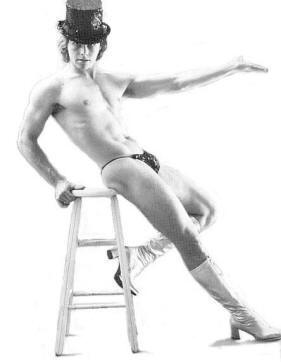
When My World Was Young 1945-56 The Yellow Brick Road 1956-60 What a Wonderful Town 1960-61
Wonderful Town (pt. II) 1962-66 The Gay Sixties 1966-70
The Juicy Life 197-76
Juicy Life (pt. II) 1976-80
Losing Alexandria 1981-87
The AIDS Spectacle
Losing Alexandria (pt. II) 1987-1990's


LOVE AND MARRIAGE...SORTA
I met Ken Hinaman on Memorial day '66 at Riis Park. After a bit of very indecisive checking each other out late in the day on the beach, I went back to the locker rooms to get ready to go home. We glimpsed each other there again, but the magnetism must have been inhibited by the dampness, I thought, since he left abruptly. But he was leaning against one of the pillars of the front portico when I came out, and he came over immediately and said with an edge of exasperation, "Do you want to go back together or not?"
We did, and he came back to my apartment to trick. That might have been it, if I hadn't found a nice greeting card stuffed in my mailbox a couple of days later with a message asking me to call him.
This summer was the beginning of my working permanently in the suburban offices of Fairfield Reading, and we began going to Riis Park together every Saturday and Sunday, and meeting for dinner sometimes during the week and sex, of course. Without thinking about it, the relationship took over and I stopped going to bars and tricking.
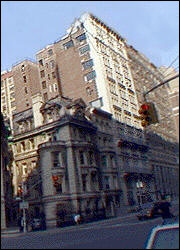 Ken lived in a large rent-controlled apartment in a
decently maintained old twelve-story building on the corner of 72nd
and Riverside. The next building was a five-story townhouse which had been
turned into a mosque; so, from the bedroom at least there were great views of
Riverside Park, the Hudson River and the Jersey Palisades. Ken's roommate had
moved out, and he was interviewing replacements with no success.
Ken lived in a large rent-controlled apartment in a
decently maintained old twelve-story building on the corner of 72nd
and Riverside. The next building was a five-story townhouse which had been
turned into a mosque; so, from the bedroom at least there were great views of
Riverside Park, the Hudson River and the Jersey Palisades. Ken's roommate had
moved out, and he was interviewing replacements with no success.
305 West 72nd St.
Earlier that spring I had moved from sharing an apartment on West 81st to living in another one upstairs by myself. But one day I came home to find that someone had dismantled the door of my old apartment and was in the process of burglarizing my former roommate. I chased the guy up the street, but didn't catch him. The incident upset me, of course, as it wasn't clear at this point that my traveling days were completely over; I was worried about leaving my new apartment unoccupied for weeks at a time in the event I did have to go out of town.
If it hadn't been for that burglary things might have worked out differently, but when after several weeks Ken was totally disgusted trying to recruit a roommate, one of us brought up the idea of my moving in. And in September '66 I moved into his place down on West 72nd.
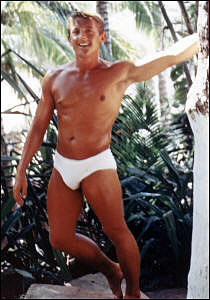 This did solve the immediate living problems
of each of us,
but, as I recall, we never sat down and discussed what our relationship was
before moving in together. But living together, sleeping together, going out
together all the time to the exclusion of anyone else, took us right into the
territory of "couple," nevertheless.
This did solve the immediate living problems
of each of us,
but, as I recall, we never sat down and discussed what our relationship was
before moving in together. But living together, sleeping together, going out
together all the time to the exclusion of anyone else, took us right into the
territory of "couple," nevertheless.
(right) Ken, 1969
Like most gay men in those years the idea of being a couple was lifted entirely from straight male-female life, replete with all the Hollywood movie romantic frosting and traditional social assumptions of het life there was no consideration to what degree these models were appropriate to two males.
Males, however, were raised with the expectation that they would become self-sufficient adults equipped to provide for themselves in life, and, in due time, for a spouse and children. The economic and decision-making role of a wife was considered to be secondary. When two guys became involved in a couple relationship, even when sharing a living space, their training to be the primary (or more powerful or responsible) partner in a couple relationship was at odds with this equation. The cultural assumptions about there being a "little woman" or subordinate role in a couple relationship would frequently meet with a lot of not-me-big-fella resistance when those expectations got aimed at another guy. Rarely was either partner prepared to just go along with "husbandly" assumptions from the other, and the jockeying around and deal-making had more in common with Sports Illustrated than Good Housekeeping and Modern Bride.
While tales of love relationships reaching across to the "wrong side of the tracks" or stories of happy kept boy arrangements abound, what I saw among guys was that they jealously guarded their individual money. Expenses were almost always split fifty-fifty even when there was an income disparity which might have suggested different proportions, and this was a major way in which a large number of gay men jettisoned some of the het tradition.
Even among heterosexuals there rarely seemed to be any consideration of whether the current heterosexual ideal of marriage as a sexually exclusive, monogamous arrangement might just be the institution of a particular time, place, culture, etc., rather than something intended, much less demanded, by Nature (or a deity.) The feminism of the era made for provocative magazine articles and lots of intellectual talk-talk....but the Real World carried on with the same ol' same ol'. And gay men were a big two steps behind on this score, never considering whether traditional het arrangements made sense for same-sex couples.
I did become aware a few years later that in the world of leathermen, there seemed to be some questioning and rejection of the heterosexual marriage ideal. Ken and I, however, did no such thing. What had started out as good sex and pleasant companionship had become living under the same roof as a couple and a whole lot of unexamined baggage came along with that.
Ken's job was doing publicity and public relations for a group of national touring companies of Broadway shows. This meant that he went on long-distance trips for two or three weeks every now and then. It was while he was on one of those trips in the early part of the following year that I discovered a gay bar in the neighborhood, the Candlelight Lounge. (And a few months later I went down to the Village with Arthur and his gang of friends to a new dance place called the Stonewall.) I resisted temptation for awhile, but then I picked up a trick in the neighborhood place, and then another and Ken on his trips did the same, I learned later. We both maintained the attitude that this conduct was wrong, and both of us took pains to conceal it the other, and both of us saw these promiscuous adventures when they came to light as threatening betrayals. But the script in our heads was a het-land fantasy almost worthy of Family Circle magazine. The amount of mutual hypocrisy and self-deception was preposterously stupid, and as it accumulated over the years it was far more of a problem than the extra-curricular sex itself.
There was one big difference in our conduct, though. Ken's tricks were one-off events out of town; whereas, mine were people we could very likely run into in the neighborhood when we were out together. Furthermore, as the months and years went on I was developing a circle of new friends and acquaintances, which because it had its origin in the gay bar while Ken was away were not mutual friends. And since these guys were associated with my extra-curricular sex, it seemed impossible to bring them into our shared life without creating a lot of ill will between us. Thus, as a couple we socialized with some of his old friends, and a small number of my old friends, but my new friends, who were becoming a major part of my life were not in the picture at least not in our picture as a couple.
EARL
 In
the late Sixties one
of the guys I met in the neighborhood was Earl, the sexually hypertrophied "Redneck" who I had
connected with that early spring morning on Central Park West just before I had
met Ken. Not long after Ken and I started living together I stopped
into the corner drugstore on the NW corner of Broadway and 72nd, and
when I took my purchase from the LP bargain bin up to the cash register the
first Mamas and Papa's recording, the one with Monday, Monday there he
was. While Earl's mule-like endowment was impossible to miss, his
personality loomed as large upon renewed encounters. He had been born
in the southern Appalachians, and left the holler that was home sometime in his
teens. Over the years he had moved from place to place up through the southern
lowlands to the Virginia Tidewater country, until finally he and a lover made
the big jump to New York City. He was in his mid-thirties, with a face
that looked like it was chopped out of wood with an axe homely as the
proverbial hedge fence, and he stood well over six foot, all bone and sinew. Earl had had little schooling
and his
travels had made him cautious and crafty, but he was wise and full of wit as
well, a part of himself he ordinarily kept hidden behind a laconic exterior.
In
the late Sixties one
of the guys I met in the neighborhood was Earl, the sexually hypertrophied "Redneck" who I had
connected with that early spring morning on Central Park West just before I had
met Ken. Not long after Ken and I started living together I stopped
into the corner drugstore on the NW corner of Broadway and 72nd, and
when I took my purchase from the LP bargain bin up to the cash register the
first Mamas and Papa's recording, the one with Monday, Monday there he
was. While Earl's mule-like endowment was impossible to miss, his
personality loomed as large upon renewed encounters. He had been born
in the southern Appalachians, and left the holler that was home sometime in his
teens. Over the years he had moved from place to place up through the southern
lowlands to the Virginia Tidewater country, until finally he and a lover made
the big jump to New York City. He was in his mid-thirties, with a face
that looked like it was chopped out of wood with an axe homely as the
proverbial hedge fence, and he stood well over six foot, all bone and sinew. Earl had had little schooling
and his
travels had made him cautious and crafty, but he was wise and full of wit as
well, a part of himself he ordinarily kept hidden behind a laconic exterior.
Earl had a true gift for effortlessly spinning out tales of his adventures often side-splittingly funny, but punctuated with ironic observations and pathos the like of which I wasn't to encounter until I read Flannery O'Connor many years later. The relationship with his lover seemed to be totally open, and not something that interfered with his seeing me, and he had no interest in mine with Ken. Earl and we saw each other on a catch-as-catch-can basis for a couple of years. He was a fascinating guy, and for all of his rough-hewn exterior, he was a thoughtful and affectionate person.
Earl was not someone whom I would have expected to meet in New York. But he was one of maybe half a dozen or so gay guys I met on the Upper West Side in the late Sixties and early Seventies who had more or less similar Appalachian backgrounds. I had only three cousins on the maternal side of my family, two of them guys. They grew up on a farm in the hill country south of the small town where I lived, and now grown up they still lived up there in dirt-road country. While meeting Earl in New York City was a surprise to me, in some ways he could have been one of these cousins.
* * *
One of the greatest pluses I've found in being gay is the tremendous variety of people that I have met and shared my life with. Judging from what I observed in the lives of straight people in the Sixties, Seventies and Eighties, as a general rule the gay guys I knew on the Upper West Side usually had a far wider variety of people in their social (and sexual) lives than straights I worked with.
White guys sleeping with men across color and class divisions seems to be sniffed at suspiciously by some academics nowadays as evidence of sexual opportunism, or "sexual colonialism" if one prefers a trendier PC term. But it was my personal experience, which was matched by that of my friends, that many of the people who became my friends and acquaintances came from the ranks of guys who were tricks first and this certainly included some guys who were of a different race/ethnicity, social class background, etc. than myself. While New York gay life was not a Liberal PC Utopia in the late Sixties, the majority of the bars I went to had mixed crowds (though how mixed varied, of course), and informal social gatherings outside of the bars, as I remember them at this time, often included Hispanic guys (of various skin colors), though few or no blacks. Of course there were gay white gay men who fastidiously "stuck to their own kind," however, on the Upper West Side and in the Village too, I don't think that this was the predominant lifestyle. Guys who were seriously under-educated or in some cases just plain not too bright had the usual tougher row to hoe though this was more the case socially than sexually. Earl, for example, was quite aware of his poor education and lack of connection to/awareness of what I guess would be called mainstream culture, and I felt that he hid behind an exaggerated "yep" and "nope" hillbilly facade in public for this reason.
It may also have been around this time that I came across a magazine article on monogamy more especially the sexually exclusive aspect of it. It may have been in Psychology Today, which was having a lot of success as a new publication. It was the first time I had read anything like it, an open discussion of various points rather than a polemic insisting on monogamy as the crowning achievement of Western Man. I made some check marks on it and underlinings, and then threw it in a drawer to read again later. When I did come across it again, I discovered that Ken had seen it in the meantime, and he had made his own tick marks and written some comments. As a result, we had some awkward but helpful talks about the extra-curricular sex aspect of our relationship.
Despite the deceit about sex, and consequent ill
feeling that would flare up as a result, our relationship on the whole was a pleasant and
cooperative one. We finished off fixing up the apartment, and bought some
additional furniture and most week nights we ate in and spent our time together
reading or watching television. We decided to give the New York City Opera a try
at one point, and bought tickets for the fall season neither of us were even
remotely opera buffs. I think I had only seen one or two performances at the
Amato Opera on the Bowery. It turned out to be something we both grew to enjoy
though we weren't made to be "opera queens" and we ended up subscribing for
both the fall and spring seasons for three years. We used to go down to the Village to
eat out on Saturday nights, usually to the Five Oaks on Grove Street, down
a long flight of stairs into the basement. It was a small place with a
passionately dedicated clientele, a good share of it gay men and women.
The food was fine, but finer was sitting into the smoky night listening to
pianist/singer Marie Blake and the entertainers she attracted. It was part
of the vintage sophistication of Greenwich Village.
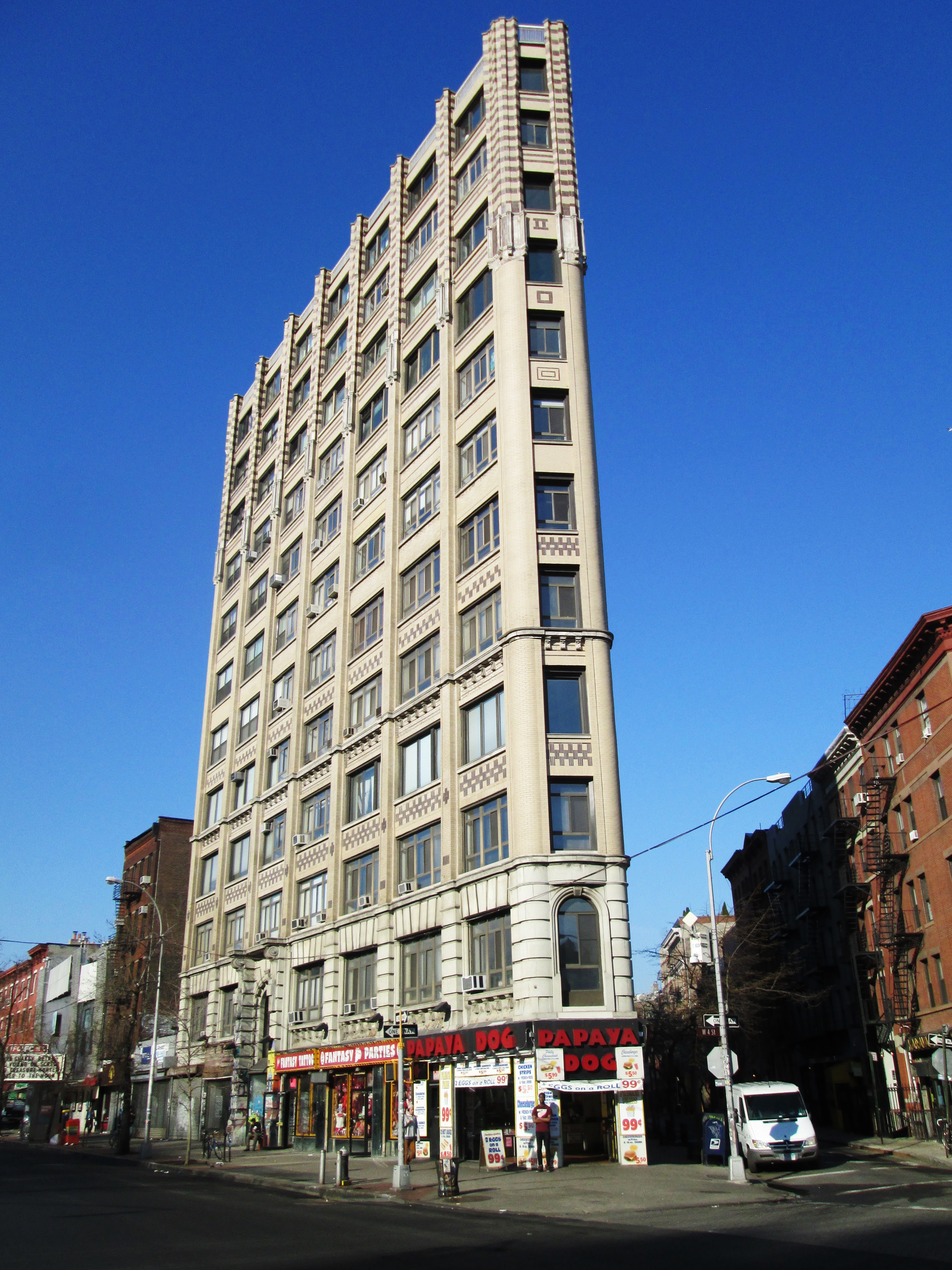 We also went to a gay
village landmark of the era, Mona's Royal Roost on Cornelia Street. The
decor was 1890's whorehouse - red flocked wallpaper with brass and phony crystal
light fixtures. The very Mona herself reigned from a back table, a portly
woman with peroxided hair, who wore beaded floor-length dresses. Usually
attended by two or more courtiers, she would when well lubricated, which was
most nights, unintentionally inform the diners in a rising voice, well-worn from
booze and cigarettes, which "goddamned son-of-a-bitch" had tried to put one over
on her that week and how she had fixed his or her ass.
We also went to a gay
village landmark of the era, Mona's Royal Roost on Cornelia Street. The
decor was 1890's whorehouse - red flocked wallpaper with brass and phony crystal
light fixtures. The very Mona herself reigned from a back table, a portly
woman with peroxided hair, who wore beaded floor-length dresses. Usually
attended by two or more courtiers, she would when well lubricated, which was
most nights, unintentionally inform the diners in a rising voice, well-worn from
booze and cigarettes, which "goddamned son-of-a-bitch" had tried to put one over
on her that week and how she had fixed his or her ass.
And then as Columbus Avenue began to gentrify commercially we went to the Red Baron in our own neighborhood too - unfortunately this gentrification did not bring with it any Marie Blakes, nor even a Mona. Both would have been pluses.
THE FAMILY CIRCLE
The relationship with my father, which had been a troubled one since late grade school and had become a loathsome chancre for both of us after he found out I was gay, came to an end in August 1967. An unloving, distant, and often ominously silent man, he sat then in a chair in his hospital room, gestured with his hands and mouthed words but as he had cancer of the trachea he could not speak...when he finally wanted to. I helped him into bed, he had a shot of morphine and we stood there and watched him go to sleep and die.
My mother panicked that I would desert her as she had been as homophobic as he had been, and worse it had been she who had tormented me with a steady stream of rebuking letters. Now she did a huge about-face, blaming him for everything; even coming to NYC to stay at the apartment with Ken and I for a long weekend with my aunt! The aggressive homophobia was on hold for almost four years, though she was constantly criticizing her sister, my now widowed Aunt Marie, But then my mother hooked up with my childhood dentist and he asked her to marry him: SPLAT!!! the same ol' shit suddenly hit the fan again. I received a disgusting letter telling me that he would divorce her if he found out about me, etc., etc., etc. I hated her for this turn-around.
But my mother had been a spoiled child and never grew into a mature adult; mendacity was one of her marked traits I had been very stupid to believe she would keep up her "reformed" act for any longer than served her purposes. She was a lifetime thirteen-year-old in the content of her character.
And so she was again the same homo-obsessed nut that she had been in the early Sixties. I was the enemy within, whose homosexuality would destroy her marriage if her new husband found out. I tolerated this any love for her had died when I was in college, but now even respect died. I continued the relationship with her only because I wanted to protect the relationship with my Aunt Marie, her sister, whom I loved very much. My mother was, if anything, even more jealous of our relationship by this time.
[When the AIDS epidemic arrived years later she declared fearfully that I could not come down there (a small retirement town in Florida) to stay if I was infected. I had never suggested the possibility. Even if I had AIDS, why would I want to go to a place with no medical facilities? And...and...and.... After a especially noisome letter in 1987, I told her that I would never communicate with her again as long as she lived. Once in 1999 we exchanged brief letters when I was preparing to emigrate, and she died three months after I left the U.S.]
A LITTLE DOPE, AND SOME DOMESTICITY
By 1968 Ken had a plum of a new job working for a top show business public relations firm, and in the spring he was working with Gore Vidal, who had a new play opening on Broadway. In late spring he began work for one of their major new clients, the Saratoga Performing Arts Center located in an old spa town near Albany. This was a major turning point in the relationship. He was away for about three and a half months, during which time my neighborhood social and sexual life bloomed. At the same time, Ken met new gay friends working up at the Saratoga Center. And he became involved in a summer-long affair with Steve (who had had a lover for a several years), who was also working in Saratoga for the summer.
Following that summer Steve from Saratoga and his lover, George, visited the city several times a year and stayed with us. They were bright and congenial guys, and the four of us became friends.
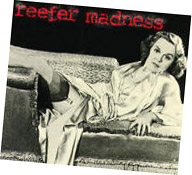 I went up there for one weekend. Ken smoked
marijuana once in awhile. I think he started a year or so after we began living
together. I'd had no
strong curiosity about grass, but I tried it just not be a wet blanket
and zip, nothing happened.
I went up there for one weekend. Ken smoked
marijuana once in awhile. I think he started a year or so after we began living
together. I'd had no
strong curiosity about grass, but I tried it just not be a wet blanket
and zip, nothing happened.
(right) Photo from 1936 film melodrama "Reefer Madness."
This particular weekend we smoked before having sex. Afterwards Ken asked, as he had in the past, whether I'd gotten high. I mumbled something non-committal, and then added, "but sex seemed to take so looooong!" (It wasn't a complaint.) He laughed, "You finally got high."
I blew grass regularly for the next twenty years. (It is probably worthy of note that over this period of time the quality of grass being sold increased enormously.)
 Despite the
glories of Timothy Leary's gospel of "turn on, tune in and drop out" as
propagated by the Hippies in the latter part of the 60's, I was not attracted by
the idea of hallucinating.
Despite the
glories of Timothy Leary's gospel of "turn on, tune in and drop out" as
propagated by the Hippies in the latter part of the 60's, I was not attracted by
the idea of hallucinating.
1966 Newsweek cover story on LSD
Moreover, it seemed to me that being gay was providing all the opportunities I needed to "drop out" and essentially the LSD/Hippie/drop-out scene looked to be a playground for white, middle class twenty-somethings. I did, however, try Angel Dust somewhere around 1970, I guess, and had a very weird, but not frightening, experience; but when I tried it a second time it was practically a non-event. However, the bad press on "dust" and some anecdotes that came my way convinced me that I'd just been lucky, and I never did it again.
Ken got interested in cooking and wine on a rather
serious level, and a spin off of this was that we had people over for
dinner more and more often.
Gracious entertaining at home (from Fellini's Satyricon, 1969)
[In the future he would open a restaurant in Texas, and later one in Southern California.]
Ken had served his military service stationed in Germany and had managed to get himself discharged in Europe at the end of it, where he stayed and worked in Paris for a couple of years or so before returning to the U.S. As a result he had various foreign friends who visited us a couple of times a year.
Living with Ken gave me my first taste of domesticity and a conventional social life since moving to New York. Prior to this my living arrangements had been more along the lines of crash pad/college dorm, and the lack of a decent paying job had kept dining out and more expensive types of entertainment beyond reach. The idea of an apartment as "home base" now really had an emphasis on home. (Although being the Upper West Side there was still a "police lock" on the door as well as the regular one.) And, in addition to the new friends of my own that I'd made in the neighborhood, I enjoyed Ken's friends from his Saratoga summer, and even more those from his European years as I'd met or known only a very few Europeans.
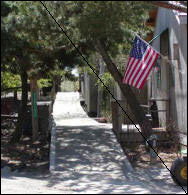 For a couple of summers we took a vacation in the Fire
Island Pines for a week, renting on a Sunday through Friday basis from a friend
Ken's. Staying there was a much different experience from my two visits to the Grove, which I
hadn't been to for two or three years now.
For a couple of summers we took a vacation in the Fire
Island Pines for a week, renting on a Sunday through Friday basis from a friend
Ken's. Staying there was a much different experience from my two visits to the Grove, which I
hadn't been to for two or three years now.
A Pines boardwalk
The Pines was a far more attractive community the building lots were much larger, so the houses were farther apart, and on the lee side of the dunes they were usually surrounded by trees and undergrowth. The overall environment was quieter and more natural. And there seemed to be far less frantic, non-stop drinking going on. On the negative side, it was more expensive to rent there and prices overall were higher. However, while men such as Jerry Herman, the creator of several hit Broadway musicals, and Calvin Klein, the clothing designer, had impressive homes there, many places were rented to groups of far less affluent gay men who took shares in a house for the summer.
JUDY GARLAND
(NO SNEERING, IT'S THE 60'S. SHE HAD TO
BE IN HERE SOMEWHERE)
In August '67 Judy Garland played four weeks at the Palace Theater on Broadway. "Judy Garland Sets the Palace Alight" was the headline on the Times review, and the reviewer began by saying:
"Judy Garland returned to the Palace last night like some raffish, sequin-sprinkled female Lazarus. That magnetic talent is alive once again in New York, and so is one of the most remarkable personalities of the contemporary entertainment scene. That the voice - as of last night's performance, anyway - is now a memory seems almost beside the point."
She was, the night we saw her, not having any voice problems, and she gave an assured, confident performance these were things she could not always deliver toward the end of her career.
The evening was marred by the
interruption of one of her cult crazies. He stood up in the first row of the
balcony just as she was getting ready to begin a number and called out..."Judy,
I love you," or something similar. These occurrences weren't unusual at her
concerts, and she had made trading remarks with these fans part of her concert
shtick.
(right) Judy Garland at the Palace '67
This was a drag queen, however, who was wearing a copy of the sequined pants suit which Garland was wearing on stage that night. Garland's response was, "Loooove your outfit," with a perfect bitch-queen imitation. (Lots of laughter.) "Where did you get it?" The question proved to be a huge mistake, as this queen would not be turned off now, and despite the singer's best attempts at a polite kiss-off and stepping toward the center of the stage this queen was not giving up her claim to the air space. The audience was rumbling, and some people started calling for him to sit down, and very quickly most of the audience was shouting for him to shut up. Garland signaled the conductor, the orchestra struck up and she went on with the show.
It was an evening of great entertainment, and most of the audience gay and straight was leaving on a high. But we overhead several knots of Garland's more morbidly obsessed "fans" exclaiming, "Oh, I thought I'd die when she almost tripped over the mike cord," or "You could see her hands shaking so badly, that I just wanted to cry," ad nauseam. The performance these people saw certainly wasn't the one on the stage at the Palace that night, but rather the fantasy of a tragic shipwreck of which they were the lucky survivors and elegiac tale-bearers. They starred in their show, Garland in hers.
Judy Garland died two years later, June 1969, of what was ruled an accidental overdose of sleeping pills. Her funeral was private, but prior to that thousands of people lined up for hours to pay their respects. It is often commented that many of them were gay men, which is true, but most were women, middle aged and older, who had loved Garland as a movie star she was theirs too. Frank Sinatra said, "She was the greatest. The rest of us will be forgotten never Judy."
Ken and I marched in at least one anti-war march together, which was the Moratorium in '69, I believe, where I recognized other gay men from the neighborhood. Like a lot of gay men we followed the infighting in the NYC Democratic Party as the Reform Democrats became top dog, and pro-gay figures like Bella Abzug and Shirley Chisolm emerged.
Our relationship became more heavily weighted on the friendship side than the romantic-sexual one, and in early 1970 we decided not to continue the sexual part of it.
As far as I had known there were no gay bars on the Upper West Side after the early 60's purge. But sometime in '66 or early '67 I noticed a "suspicious looking" place. It was called Milano's, and it was across from Verdi Square near the northeast corner of Amsterdam and 72nd. There was nothing special about it to notice really, and I'd passed it a lot. But one day as I walked by I happened to glance at the window. There was a guy sitting there and he locked eyes immediately, and stayed glued to my eyeballs until I looked away. The bad news was he looked like someone you could to hire to knife your rich grandmother. I furtively glanced in the window a few more times when I had to pass, but either the bar looked empty or someone else from the Most Wanted list was checking out the street. My thought was that maybe the place got some rough trade as customers. Verdi Square had the well-earned reputation for being a gathering place for low life. Sherman Square, which was the area just south of the IRT subway entrance on W. 72nd was original "Needle Park", but Verdi Square on the north side of the street soon shared that nickname. (Milano's, I learned later, had been pretty much what I guessed available guys, but not trustworthy, some outright dangerous perhaps. Gay? Maybe, maybe not.)
Someone, and it may have been Ken, told me there was a gay bar a little further up Amsterdam Avenue. Whoever it was, I remember that they thought it was a truly lousy place. The street lighting was still only slightly brighter than a coal mine, and Amsterdam was a consistently dumpy part of the neighborhood. I wasn't sure how I liked the idea of checking it out alone at night in the event it turned out to be anything as uninviting as Milanos looked.
As usual second thoughts won out over what had seemed wiser ones. I found the place one night at mid-block on the east side of the Amsterdam, between 75th and 74th. The first time I didn't even go in. Though I could see a couple of men at the end of the bar, I could hardly make them out the place was so dark...I walked past a couple of times. No one came in or out. Uh-uh, I chickened out.
But it may have been the next night that I went back to reconnoiter again. There were more guys at the end of the bar, and a bald, gnome-like man with a doleful expression sitting in the window. Holy shit, even worse. But, then I saw someone, or maybe a couple of someones, going in or out, and decided they looked gay yeah, do it.
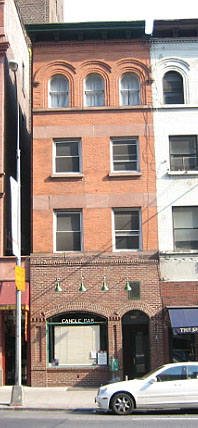 The place was called the Candlelight Lounge back then,
later it was just the Candle Bar. I was going there by February '67 so my first
visit might have been late the year before. The bar had been operating as a gay
bar before I started going there, which means I think that it
probably ended up being the oldest continuously operating gay bar in New York City. (Julius's in the
Village has been open much longer, of course, but for most of its history it was
a straight place. When it began attracting a noticeable minority of gay customers
in the 60's it kept up a steady campaign of trying to get rid
of them; so, until the Sip-in it's not appropriate, to my way of thinking, to
consider it a gay bar.)
The place was called the Candlelight Lounge back then,
later it was just the Candle Bar. I was going there by February '67 so my first
visit might have been late the year before. The bar had been operating as a gay
bar before I started going there, which means I think that it
probably ended up being the oldest continuously operating gay bar in New York City. (Julius's in the
Village has been open much longer, of course, but for most of its history it was
a straight place. When it began attracting a noticeable minority of gay customers
in the 60's it kept up a steady campaign of trying to get rid
of them; so, until the Sip-in it's not appropriate, to my way of thinking, to
consider it a gay bar.)
Candle Bar in 2006, for many years NYC's oldest continuously operating gay bar.
[It finally closed in 2015.]
The Candle in later decades looked much different inside than it did then. The building, and in fact most of the block, has been beautifully restored. The actual bar space was smaller as well. There was a bar with stools on the left side as you entered and enough room for an aisle to the back. The place got wider at the end of the bar. There was a juke box on the right and a mechanical shuffle board game. (The shuffle board game was obnoxiously loud and intrusive in such a small space.) There were booths with tables against both walls, and the middle of the room was crowded with tables and chairs. The tables were covered with red cloths. There was a men's room behind this on the left, and an unused kitchen on the right. The booths and tables weren't used a lot, and they wasted what could have been standing space for more customers.
The customers were a group of ordinary guys in casual clothes, mostly in their late twenties, I guess. It was clear from the buzz of conversation that a lot of them knew each other. I wasn't very comfortable as I got the feeling that I was one of the few people there alone. However, I did go back it was too convenient not to, a ten minute walk away.
Occasionally in these same years I went to the Old Vic on the East Side or the Stonewall or Kellers in the Village; and then later, the International Stud and the Snake Pit opened in the Village too, and I think even the Triangle was open by '69. (Stonewall and the Snake Pit both had good music and dancing.) In '71 I was still going down to the Triangle and the Zodiac sometimes and there was an after-hours place on Christopher, called Christopher's End. But more and more often in the late 60's I just walked over to the Candlelight Lounge. From 1966 on I almost never had to travel out of the city on my job. After living on the Upper West Side for most of my six years in New York, finally I was doing my socializing there and getting to feel that it was really my neighborhood.
 The worried little gentleman I'd seen sitting in the window
was known as "Sweet William." The story was that he was there to keep an eye on
the place for the owners and/or that he was the front man whose name appeared
as the official licensee. His duties appeared to weigh heavily on him. He was
a short, stocky man, and periodically he would slide wearily off of his stool in
the corner by the front window and trudge through the bar, fingering a string of
komboloi/worry
beads and looking troubled. The bartenders treated him with a kind of jocular
deference. And after a time quite a few of the customers were greeting him as
he wandered through the place, which seemed to delight him. It had become
clear, I guess, that he was essentially just putting in his time. It had become
equally clear that his reticence and unhappy appearance were likely due to
terminal boredom. The story was that not only was he straight, but Albanian as
well, with only a nodding acquaintance with English. The real owners were
allegedly a Greek-American family who owned a restaurant on the Jersey shore of
the Hudson. And, indeed, there was a very brief period when a middle-aged Greek man and his young, attractive son appeared and took a hand at tending
bar. Despite doing their best to be friendly, neither they nor the customers
were truly comfortable with each other. They disappeared...as did Sweet William at some
point.
The worried little gentleman I'd seen sitting in the window
was known as "Sweet William." The story was that he was there to keep an eye on
the place for the owners and/or that he was the front man whose name appeared
as the official licensee. His duties appeared to weigh heavily on him. He was
a short, stocky man, and periodically he would slide wearily off of his stool in
the corner by the front window and trudge through the bar, fingering a string of
komboloi/worry
beads and looking troubled. The bartenders treated him with a kind of jocular
deference. And after a time quite a few of the customers were greeting him as
he wandered through the place, which seemed to delight him. It had become
clear, I guess, that he was essentially just putting in his time. It had become
equally clear that his reticence and unhappy appearance were likely due to
terminal boredom. The story was that not only was he straight, but Albanian as
well, with only a nodding acquaintance with English. The real owners were
allegedly a Greek-American family who owned a restaurant on the Jersey shore of
the Hudson. And, indeed, there was a very brief period when a middle-aged Greek man and his young, attractive son appeared and took a hand at tending
bar. Despite doing their best to be friendly, neither they nor the customers
were truly comfortable with each other. They disappeared...as did Sweet William at some
point.
The bar's owners were now said to be a couple known as Sonny and Jenny. Sonny Tobin, according to an unkind reference at one time or another in one of the tabloids, had been a minor figure in the waterfront rackets. Jenny would go on alone, Sonny having died to be the reputed owner in future years of several other gay bars in the neighborhood, and for this she got her own snide reference in the press in the early 70's...this time New York Magazine. Jenny witnessed Sonny getting gunned down in front of their home in late 1978, but she carried on managing what amounted to a gay bar realm of no small size by herself.
There were three night bartenders at the Candelight Lounge: Denny, the manager, was a soft-spoken fellow, tall, thin and nice looking, probably in his late thirties or even early forties. I can remember having a conversation with him once about the New York bars I went to in '59, but the ones he looked back on fondly were the Cork Club and Artie's from the early Fifties. Earl was short and very cute, in his early/mid-twenties and a bit though engagingly ditzy. And the other one, who became a friend in the early Seventies, was Larry Clinton. He was very tall and thin, with a kind of theatrically homely face, and a dry, but outrageous wit.
The day bartender was a lesbian named Maureen, or Moe. She would sometimes drop in during the early evening, though she rarely stayed long, being far too savvy not to know that women weren't good for business in a men's gay bar. I can only remember one female customer, who appeared for a brief period of weeks in the early evening sometimes. She was an older straight woman who worked as a bartender somewhere, and she told me she picked the Candlelight because she could drink there without men trying to hit on her. Very infrequently guys might bring in a female friend to the bar, but everyone knew that an extended visit was a royal road to unpopularity with the other customers.
[I never visited a lesbian bar. But on two different occasions in these years I did listen to some brief comments by different women about thoughts about men customer's in lesbian bars. Their idea of a straight guy coming in was on par with having a cockroach perched on your birthday cake. If a female patron brought a gay guy along, this was tolerated but not really welcomed. So, it seems attitudes were similar on both sides of the gay coin.]
I didn't go to the Candlelight Lounge habitually yet for a couple of years, and most of the people I met initially were pickups for sex. However, my first impression that the bar was a place where a lot of the people knew each other was right. The Candlelight Lounge was as much perhaps even more in these days a social meeting place as it was a cruise bar. This part of the Upper West Side was still dingy or worse, and no one was likely to come up there purposely to cruise in a bar, which meant the clientele remained a crowd of local guys. The atmosphere and energy of the place were low, curiously reminiscent of how I remembered many New York bars being in '59 and this was seven years later. Guys stood around talking quietly, for the most part their body language was restrained they could have been standing in a subway station. The music provoked some foot tapping or a little head bobbing. And some of it was the actually the same music certainly the same genre and artists as what I had heard when I first arrived in the city! The Candlelight Lounge was a bit of a time warp at this point.
Later, as the neighborhood improved and the gay population increased, other bars opened. There were many more people in the bars then who didn't know each other, and the amount of cruising activity rose. Still, some of these bars retained that quality of neighborhood center/social club for a core of customers. These were still the places a guy could go to find someone to paint his apartment, locate an inexpensive dentist, get an apartment cleaner, a mover, a resume written, etc. if your own friends didn't know, ask your casual bar acquaintances and tricks, and best bet asking the bartenders. And, of course, gay bartenders - even more than straight ones, I think - are famous for being confidants, confessors and shoulders to cry on for some of their customers, which is a draw of its own.
The Candlelight Lounge's customers were white Americans and Hispanics. My recollection is that a consistent quarter of the crowd was Hispanic (Cuban and Puerto Rican mainly), though that proportion could go higher on weekend nights. This was a change from previous places I'd hung out in, where I'd been unaware of Hispanics as being a large part of the crowd. There were only a very few blacks who came to the bar. The guys mixed and used the space with no regard for ethnicity. Cliques of friends were often composed of American and Hispanic guys, and the circles of bar acquaintances were completely mixed. Ethnicity didn't seem to play the slightest part in who tricked with who, and it may be that the tricking was actually the origin of the easy-going mixed socializing.
"Leave it to Little Mary Sunshine..."
I had seen the Off Broadway musical Little Mary Sunshine with some friends in 1962 at the Orpheum on Second Avenue, formerly a venue for NYC's once thriving Yiddish theater. Nowadays the show would probably be skewered as racist - or totally non-PC, at least - but it was a harmless send-up of the old Jeanette MacDonald Nelson Eddy romantic cornball movies of the Thirties and Forties. There are two American Indian characters in the cast, and at one point we were sitting in a front row I was unnerved to realize that one of them had his eyes glued on me. And in a later scene it happened again. A few days after one of my friends, who knew the actors, told me, "Oh, so-and-so was interested in you..." or something to that effect. And that was that.
One night in February '67 - five years later - I saw a guy in the Candlelight who looked familiar immediately, but I had no idea who he was. He saw me, and clearly recognized me. He came over, held out his hand and said, "Hi, I was the Indian in Little Mary Sunshine." Ah yes. And this time that was not just that.
The next night I was in the bar, an acquaintance who'd been standing next to me at the time said, "Jesus, that guy had some ego the way he introduced himself. You would've of thought he'd had the lead in Sweet Charity!"
After a couple of years (by 1969) I knew enough people in the Candlelight that I was going there regularly to hang out with the friends I'd met, as much as for the sexual opportunities though these were rarely lacking, and rarely declined.
The bulk of the customers were guys in their twenties or early thirties, with a very much smaller number being in their forties. Many of the guys had office clerical jobs, some had technical skills, and - typical of the Upper West Side population in general, I think - there were a fair number of customers connected with theater or the arts. I met only one guy there in these years who was well established in a profession or business and/or had a more than modest income. (Years later he had become a major figure in NYC cultural life and television.)
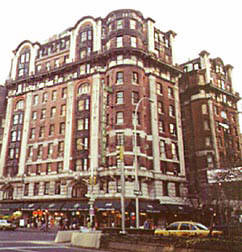 On the other hand, there were those guys who scrambled hard to
make a small living lunch counter waiters, stockroom clerks, porters,
handymen, unlicensed haircutters and a handful of guys who seemed more often
unemployed than not.
On the other hand, there were those guys who scrambled hard to
make a small living lunch counter waiters, stockroom clerks, porters,
handymen, unlicensed haircutters and a handful of guys who seemed more often
unemployed than not.
The Belleclaire
At this time some of the old, rundown hotels in the area of Broadway & 72nd St. area, (the Belleclaire, for one), were home for some of the guys I knew who were on the really low end of the job scale. (The Belleclaire, a gorgeous early 20th century building was to have even more horrible days as a welfare hotel in the 80's before being restored in 2004 to something like its former grandeur.) Like Larry, Don and I had done in the Tiltin' Hilton, these guys lived two and three together in order to make even these seedy accommodations affordable.
That all-important gay bar shrine in the Candlelight Lounge, the juke box, sucked. And it sucked big time. It contained an undistinguished menu of pop and rock with a very small dash of Motown. If it weren't for some Judy Garland, Billy Holiday and Dinah Washington, it could have graced a bowling alley in East Armpit, Nebraska. New songs that showed up were dying by the time they arrived and in some cases should have died before.
There was no Latin music on it either, despite the Hispanic patrons, but this always was the case in any Manhattan gay bars I went to over the years. It seems very odd, though, given the large Hispanic population on the Upper West Side at this point that it had not developed something like the current Latino gay scene in Jackson Heights/Woodside, Queens. The 415, a dance bar at Amsterdam & about 81st St., had been heavily Latino, but it was closed in '59. Perhaps there were Hispanic gay bars farther uptown on the West Side, but I do not recall ever hearing of any.)
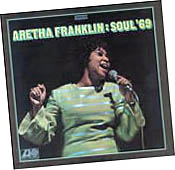 This was not a jukebox you could have put into Stonewall or Kellers
during the late Sixties. Despite grousing by the customers, the jukebox improved with the
enthusiasm of a would-be suicide. The bartenders, Earl and Larry, parried
complaints without actually giving out any information about the source of the
problem at first, and if Denny, the head bartender, had anything to say on the topic he
must have said it very quietly. At some point, with a stagy "secrecy" and some
outlandish concealed finger-pointing, Larry identified the quiet and affable
Denny himself as the villain! Denny was not crazy about most rock music it
seemed, but he really disliked R&B and Soul. And as the manager he was able to
muzzle the juke box.
This was not a jukebox you could have put into Stonewall or Kellers
during the late Sixties. Despite grousing by the customers, the jukebox improved with the
enthusiasm of a would-be suicide. The bartenders, Earl and Larry, parried
complaints without actually giving out any information about the source of the
problem at first, and if Denny, the head bartender, had anything to say on the topic he
must have said it very quietly. At some point, with a stagy "secrecy" and some
outlandish concealed finger-pointing, Larry identified the quiet and affable
Denny himself as the villain! Denny was not crazy about most rock music it
seemed, but he really disliked R&B and Soul. And as the manager he was able to
muzzle the juke box.
I do remember when one Aretha Franklin song showed up - Chain of Fools, I think it was - and I poured coins into the box. It must have driven him mad. He probably wished I'd get hit by a truck on my way to the bar.
In the following decades the Candlelight Lounge/The Candlelight/The Candle went through several cheapo makeovers, but in the Eighties Robert Ader, a new gay owner, did a big renovation and so totally changed the atmosphere that the place could have easily fitted into Christopher Street or Chelsea. But the doyen of NYC gay bars is scheduled to do its final trick on June 22, 2015: to close its doors for the last time. And with that the final vestige of pre-AIDS gay life on the Upper West Side will disappear.
HAM & EGGS AND "THE GREEKS"
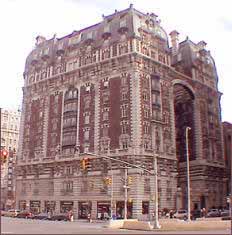 There were two places that people
went to eat after the bar closed at 4 a.m. (or 3 a.m. on Sunday mornings.)
There were two places that people
went to eat after the bar closed at 4 a.m. (or 3 a.m. on Sunday mornings.)
The Dorilton
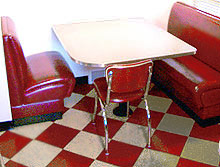 One was the Ham and Eggs
restaurant on the east side of Broadway at 71st.
My recollection is that it occupied the corner commercial space of the Dorilton
apartments, an outrageous Second Empire tart of a building fallen on evil days, which had it been a person could only have been Zola's courtesan,
Nana. Ham & Eggs was a fairly large place, and pretty busy at that time of night. Many,
probably most, of the patrons were straight, but it usually attracted a small,
but conspicuously loud and showy crowd of a half dozen or so effeminate young
queens. They sat at the counter space nearest the door when they sat at all -
but were usually running back and forth to the street. They were slap queens
(slap = makeup), though a more daring one or two might show up in drag or an ambiguous
ensemble that bordered on it. They spent a lot of time on the pay phone, and
parading back and forth along the curb in front of the place - like tawdry,
street-walking versions of Zola's magnificent whore. The lucky ones might meet a john and get whisked away in a car. As I recall, the place closed
not long after I started going to the Candlelight Lounge.
One was the Ham and Eggs
restaurant on the east side of Broadway at 71st.
My recollection is that it occupied the corner commercial space of the Dorilton
apartments, an outrageous Second Empire tart of a building fallen on evil days, which had it been a person could only have been Zola's courtesan,
Nana. Ham & Eggs was a fairly large place, and pretty busy at that time of night. Many,
probably most, of the patrons were straight, but it usually attracted a small,
but conspicuously loud and showy crowd of a half dozen or so effeminate young
queens. They sat at the counter space nearest the door when they sat at all -
but were usually running back and forth to the street. They were slap queens
(slap = makeup), though a more daring one or two might show up in drag or an ambiguous
ensemble that bordered on it. They spent a lot of time on the pay phone, and
parading back and forth along the curb in front of the place - like tawdry,
street-walking versions of Zola's magnificent whore. The lucky ones might meet a john and get whisked away in a car. As I recall, the place closed
not long after I started going to the Candlelight Lounge.
The more popular place with the bar's customers was "the Greeks," a small place with a counter and booths on the northwest corner of 75th and Amsterdam. It was the stereotypical greasy spoon coffee shop staffed by a bunch of middle aged and older Greek immigrant men, and was complete with a few small icons taped to the kitchen wall. It was probably the greasiest food I've ever eaten and "breakfast" was usually two big cheeseburgers served on Kaiser rolls with a mountain of home fries and a milkshake. Delicious!
Shortly after closing a dozen to twenty or more of the bar's customers would descend on the place, overwhelming the handful of straight night owls. The head counterman was Chris, a very tall, skinny, craggy-faced older man with a loud voice and bristling manner. At this hour he usually wore an expression that looked like he was ready to bite someone's head off, and he slammed the dishes down on the table or sometimes spun them down the counter. In fact, he was a very cool number. The guys from the bar were often well oiled by this time, of course, so they were noisy, horsed around and more than one person usually managed to spill a cup of coffee or knock a plate of food on the floor. But Chris dealt with it with something roughly akin to the forbearance of a seasoned playschool teacher.
He was, however, a 100% I-do-not-take-shit-from-anyone character. The expression hadn't been coined yet, but "Chris Rules" was the name of the game. When there was bad behavior, Chris shouted at the top of his lungs and stepped in and quashed the problem. One night I saw him roar at a bunch of straight troublemakers, and then he pulled out a cleaver he kept under the counter in what was clearly a move to begin summary executions.

As the guys from the Candlelight all more or less knew each other, they didn't always keep a lid on the gay banter or sexual comments. Straight late night drinkers from the neighborhood and night shift workers who stopped in regularly pretty much ignored the gay guys and their hullabaloo. But strangers could get freaked. Unfortunately, the strangers were often groups of black guys or several black couples on their way uptown from an evening in Midtown. This, I think, exacerbated the situation tension between blacks and whites was rising in urban areas. If they started coming on with loud anti-gay remarks, then Chris would intervene and the black guys could become very threatening my take was that they deeply resented a white man coming down on them for ranking on a bunch of faggots, and saw it in terms of racism, white siding with white. And then there was Chris's manner of taking orders and serving customers, which certainly must have set any stranger on edge first thing. Fortunately, if the Greeks called the cops, the police car seemed to practically spring up out the concrete. I wouldn't be surprised if the cops were well aware of Chris's iron rule and handy cleaver (they did stop in for coffee themselves), and they probably knew if there was a call it was potentially serious.
Such, was post-bar dining elegance on the late Sixties Upper West Side. The Brasserie it was not.
During the day "the Greeks" got some of the same gay guys for customers, and though Chris could never have been called Mr. Charm, he was friendly with his gay customers from the early morning hours. (When did he sleep I used to wonder.)
ROCK AND SOUL


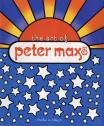



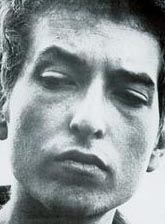
As the Sixties chugged toward their climax or collapse, depending upon the latest news bulletin, rock music was tilting heavily toward druggie escapism, alienation, "love," social protest and anti-war themes, all served up as pseudo-folk, acid and psychedelic rock or plain old mega-decibel stuff - packaged by Dylan (master songwriter/lousy singer/worse attitude), the Doors (featuring Jim Morrison and his big basket in tight leather pants, with occasional weenie waving at performances), Jefferson Airplane later changed to Starship - (whose entire existence could be justified by Grace Slick singing White Rabbit)...Moby Grape, Pink Floyd, the wonderful Moody Blues, Grateful Dead, et al. And in their own special categories, were the Beatles and the Stones.
WNEW-FM was the vanguard station for this music in the city, and beginning in 1966 female DJ Alison Steele - famous as the Nightbird - its high priestess.
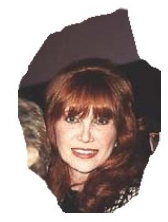 "The
flutter of wings, the sounds of the night, the shadow across the moon,
"The
flutter of wings, the sounds of the night, the shadow across the moon,
as the Nightbird lifts her wings and soars above the earth into another
level of comprehension,
where we exist only to feel.
Come fly with me, Alison Steele, the Nightbird..."
Alison Steele, the Nightbird
The first night she was on, Steele opened with some poetry she had written, Andean indigenous music, and the Moody Blues' Nights in White Satin. "The switchboard lit up," she recalled later and from then on, while what was called "progressive" music was at its height, she ruled, but graciously. Jimmy Hendrix's song Nightbird Flying was his tribute. "I knew how to do a program that was more conceptual than anyone else." She selected her own playlist and did, indeed, have a true gift for putting together album tracks night after night into incredible listening experiences.
While WNEW had the reputation as the stations for "heads," Alison Steele had for a few years no lack of gay listeners. However, I am not aware that she ever acknowledged that even at a later point in her long career. Perhaps she never knew, or perhaps gay "heads" were no more remarkable to her than straight ones.
Barbra Streisand brought out two more albums in '66, and seemed to have the ballad singer/Broadway/TV star field to herself. She was already slotted in as the new Judy.
But the chinkachinkchinkchink rattlesnake roll of the tambourine and the punchy, driving lyrics of black music kept right on coming through. (Though certainly not on WNEW!)
Otis Redding came into his own in '65/'66 with an
incredible group of songs, among which were "Respect" and "I've Been Loving You
Too Long." He died the following year in a plane crash, age 27, otherwise
he probably would have been a major R&B/Soul star for decades to come.
Redding's recordings caught the attention of gay men, which was a
significant departure in a subculture that had traditionally prized mainly
female singers - and in days past, the weepier and torchier, the better.
But there were enough white gay men now who had taken to black urban music in
their teens that they brought about a major innovation in the musical tastes of
the gay world, one equal in its own subculture to that which occurred in the early
Fifties when white American teenagers had embraced Rhythm 'n' Blues and left the ballads and
novelty songs of the white Hit Parade behind. The world of the Sixties was
shaking -- in many ways. Despite their undoubted greatness, the likes of Judy Garland,
Sarah Vaughan and a constellation of other stars, nor the music of the New York
cabaret scene and Broadway, didn't and probably couldn't accommodate the
energy and assertiveness, the grit, joy and exuberance of current gay life.
Certainly not in New York. 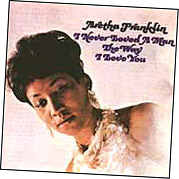
Spring of 1967 Aretha Franklin's album, I Never Loved a Man the Way I Love You erupted onto the scene. A not especially noteworthy performer for Columbia, she had moved to Atlantic records, and teamed with the Muscle Shoals studios' rhythm section she unleashed a fiery, soulful sound that gave another dimension to black pop music. "Respect," (the same Otis Redding song) "Dr. Feelgood," "Do Right Woman-Do Right Man" and the title song all placed at Number One or high in the R&B and Pop Top 40 listings, as did some of the remaining cuts as well. She was a national sensation, and her music electrified gay men.
By this point, if not a couple of years earlier, gay music tastes were better gauged by the R&B chart than the pop one.
Just why is demonstrated by another powerful song from
Franklin's 1968 album, Aretha Now.
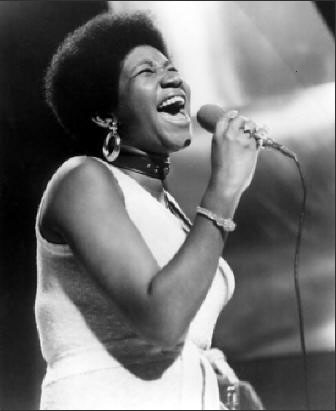
Think think think think think think
think think think think think thinkYou better think think think about what you're trying to do to me
Yeah, think
Think, think!Let your mind go, let yourself be free
[ ]
You better think think think about what you're trying to do to meYeah, think
Think, think!Let your mind go, let yourself be free
Oh freedom freedom, freedom freedom,
freedom, yeah freedom
Freedom freedom, freedom freedom,freedom, ooh freedom
(music & lyrics by Aretha)
The music starts in high gear and stays there like an excerpted run from a gospel song the instruments sustain an urgent support for Aretha's intense delivery of what is half anthem, half rebuke...an ambiguous blend of lyrics that suggest the sexual wrapped in a broader societal invocation. It's one hell of a lot grit and defiance and soaring passion packed into slightly over two minutes.
And it could be appropriated with a virtually perfect fit by gay listeners, which is why it stayed on the juke boxes of gay bars well into the Seventies.
What "Rock" and folk of almost any stripe lacked was gonads, and while gay spokesmen from the late Sixties to the Nineties have always writhed in abject discomfort at the thought, every average gay grunt on the street has always known that the root issue of their freedom is sexual. Gay liberation shares with at least one religious denomination the distinction of being a movement sprung from the human crotch, not the head. Fundamentally gay freedom is not about where you sit on the bus, or whether you can join their country club, nor is it about serving in the army, nor getting married or nor having/adopting children, or even who you love it is about that most basic and personal of human activities who you have sex with. It is about the body the visceral, the hormonal, the guts, the sweat, the smell, the feel...and those holes. All other issues proceed from this. And if it wasn't about who you want to fuck with, there wouldn't be any other questions or issues.
The industry publicity and reviews of the 2005 film, Brokeback Mountain even in gay media and discussion groups, which should know better pulled out all the stops in de-sexing the story to make the movie a het-acceptable love story. Yet, it is only because sex is initiated and continued by two men that there is a story! However, such is the fear of gay sex and the power of homophobia that the film was gelded by denial. So much for "progress" in the post-AIDS GLBT world.
Gay men in the late Sixties followed the current music that was most emphatically a musical invitation to move the body, with lyrics that entwined sex and romantic relations with freedom, release, and defiance.
Rock Mick Jagger and the Stones' borrowings from American blacks notwithstanding did not have an ass. A gay black friend called the Stones a white minstrel show not off the mark considering that in their first three years the group used songs of black artists Muddy Waters, Chuck Berry, Willie Dixon, Howlin' Wolf, Little Richard, Robert Wilkins, Jimmy Reed, Bobby Womack, Bo Diddly, Slim Harpo and the Staple Singers. Perhaps Ike and Tina Turner had something like that in mind when one of their albums featured close-up headshots of the two of them painted in white-face makeup and chowing down on giant slices of watermelon.
I remember a ride home from the suburbs in 1968 with five other young Fairfield people packed into a company car, and getting an object lesson in the big split taking place in popular music. The Beatles had just come out with a new song, which the DJ on the car radio was repeating every five or ten minutes and each time everyone (including me) would cheer and sit there nodding their heads in time with the music, like a car full of bobble birds.
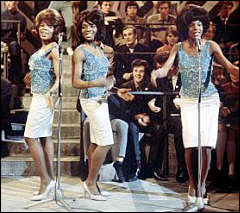 The same week one of
the big soul artists had come out with a new song maybe it was Marvin Gaye
with "I Heard It Through the Grapevine," I can't remember, or Martha and the Vandellas' "Love Bug," perhaps.
The same week one of
the big soul artists had come out with a new song maybe it was Marvin Gaye
with "I Heard It Through the Grapevine," I can't remember, or Martha and the Vandellas' "Love Bug," perhaps.
(right) Martha Reeves & the Vandellas
The DJ was repeating it too, though not nearly as frequently which put me off, but nobody else. I noticed that when it played, the others would start the head bobbin' and then fizzle out with it it just didn't go downstairs with them. Meanwhile, in a packed car I'm trying not to gyrate around too much so as to bruise the hips on either side of mine.
Straight white young people seemed to want to keep their music, literally, in the head. A little soul was cool, but they had seat belts on their asses. Yet I remember a bunch of white gay men in 1967 listening to Tina Turner's pulsating "Shake a Tail Feather," and they got out of their chairs to listen not because they thought it was the national anthem, but because you can't move your bottom half sitting down.
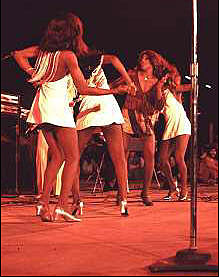 Rock
music might have its sex symbols, Jim Morrison and Janis Joplin, for
example, and it even managed to look like sex sometimes, though usually in the
form guitar masturbation. But no one would confuse or ever compare
Morrison and
Joplin with James Brown and Tina Turner. And no one in the next couple of years
would think that Woodstock was taking place in the same world as the Apollo Theater
or the Ike and Tina Turner
Review they weren't.
Rock
music might have its sex symbols, Jim Morrison and Janis Joplin, for
example, and it even managed to look like sex sometimes, though usually in the
form guitar masturbation. But no one would confuse or ever compare
Morrison and
Joplin with James Brown and Tina Turner. And no one in the next couple of years
would think that Woodstock was taking place in the same world as the Apollo Theater
or the Ike and Tina Turner
Review they weren't.
Tina Turner & the Ikettes (John Levy photo)
Rock did not have a bootie. Rock would never shake its groove thang.
Rock did not "get down," and Rock was not about to go near any it that was paired with get down, as in "get down on it!"
What had come to be called "soul music" was urban, gritty, defiant, full of sass, challenge and ridicule, and it was emphatically physical. It breathed hard, it growled and when it let go, it yowled.
"When I think of soul, I think of grease -----
and there ain't nothin' no good without the
greasssse!"Tina Turner, Carnegie Hall Concert
April 1971
It was ready-made for the emerging gay life. What was now called "Rock" was just on the verge of finding the center of its fan base in the young white males of the suburbs.
By the turn of the decade you could have walked into any empty bar in the Village or the Upper West Side, and just by checking the juke box known whether the place was gay or straight. I still used to go out to lunch and drinking after work with the young, straight people I worked with fairly sometimes during these years. We went to bars in the suburb where Fairfield Reading had its office, and to bars popular with young people on the Upper East Side and in the Village. In these places the amount of soul music probably never got higher than a quarter at very most, a third of the total selections, while in gay bars soul music had all but pushed rock off the juke boxes.
ALL THE NEWS IS BAD TODAY
In retrospect America in the second half of the Sixties is often is presented as something of a three-ring circus the Hippies, the racial conflict and the growing anti-Vietnam war sentiment each occupying its discrete ring in the overall razzle-dazzle. At the time, reading news magazines and the newspapers and watching television felt more like the top of your head had been taken off and someone, or something, was going at it with an egg-beater. The 6 O'clock News was like an attack of vertigo...whatever the actual significance of the events of Stonewall, it is not surprising that something, such as Gay Liberation, which began in the late Sixties, should be assumed to have started in a riot.
1967
That conglomeration of groups, gurus, ideas, music events and good times which were clumped together as "Hippie" were having some success enticing Americans into the joys of public nakedness and pre-marital sex and drugs. This looked to be culminating in the 1967 "Summer of Love" in San Francisco's Haight-Ashbury Hippie enclave; however, in distant New York it was probably just as much the cover and feature article in the very un-Hippie Time magazine that July and the opening of Hair (subtitled: The American Tribal Love/Rock Musical) at Joe Papp's Public Theater later in the year.
However, the country was not entirely all soft and runny with L-O-V-E, love.
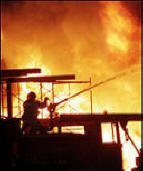 While
the cast of Hair was practicing "Let the sun shine in...," thousands and
thousands and thousands of black Americans were screaming Burn, baby, burn!
Boston, Tampa, Buffalo, Wilmington, and more than one hundred other U.S. cities
were convulsed with rioting and arson this summer. The scale of destruction and
violence in Detroit was on a par with that of a war zone. And Ken and I could
look out the window of our apartment, and see the skies lit up with the fire of
a burning Newark just across the Hudson that city was declared to be in "open
rebellion." Federal troops entered Newark and Detroit to suppress the uprisings
there. The extent of death, injuries, property destruction and financial loss
across the nation had not been this great since the Civil War. The cost in
intangible terms was probably greater.
While
the cast of Hair was practicing "Let the sun shine in...," thousands and
thousands and thousands of black Americans were screaming Burn, baby, burn!
Boston, Tampa, Buffalo, Wilmington, and more than one hundred other U.S. cities
were convulsed with rioting and arson this summer. The scale of destruction and
violence in Detroit was on a par with that of a war zone. And Ken and I could
look out the window of our apartment, and see the skies lit up with the fire of
a burning Newark just across the Hudson that city was declared to be in "open
rebellion." Federal troops entered Newark and Detroit to suppress the uprisings
there. The extent of death, injuries, property destruction and financial loss
across the nation had not been this great since the Civil War. The cost in
intangible terms was probably greater.
The country was emotionally in turmoil and exhausted, and glad when winter approached. Had we only known what was ahead the entire nation would have stayed in bed with its head under the covers for the entire next year.
1968
In January, during a holiday truce, the Communist forces in Vietnam launched a major surprise offensive against American and South Vietnamese forces on the eve of the Tet (lunar New Year) celebrations. Provincial capitals throughout the country were seized, garrisons simultaneously attacked and, perhaps most shockingly, in Saigon the U.S. Embassy was invaded.
Tet clearly demonstrated that the optimistic statements U.S. spokesmen had been making about Communist weakness were a bunch of crap measured against the strength the Communists had shown in this battle. When the same spokesmen said after the Tet Offensive that the Communists had been badly weakened, they were telling the truth for a change, but they had a lot of trouble persuading now anyone to believe them. When General Westmoreland, the US commander in Vietnam, asked for 200,000 more American soldiers for Vietnam, this made people even less willing to believe that the Tet Offensive had been a brilliant American victory.
The cost in North Vietnamese casualties was tremendous but the gambit produced a pivotal media disaster for the White House and the presidency of Lyndon Johnson. The strategy toppled the American president. It turned the tide of the war.
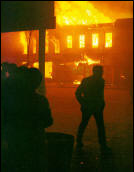 It was unbelievable when on April 4th news
bulletins announced that Dr. Martin Luther King, Jr. had been shot by an
assassin in Memphis then that he was dead. It was as gut wrenching as the
assassination of JFK, but the follow-up to the president's death had been a
period of national unity in mourning.
It was unbelievable when on April 4th news
bulletins announced that Dr. Martin Luther King, Jr. had been shot by an
assassin in Memphis then that he was dead. It was as gut wrenching as the
assassination of JFK, but the follow-up to the president's death had been a
period of national unity in mourning.
Washington, DC 1968
The aftermath of the King assassination began immediately in an outpouring of Afro-American fury and sorrow that set Detroit ablaze again and Boston, Chicago and over one hundred more towns and cities. In Washington, the nation's capital, troops protected public buildings as fire destroyed block after block of the city. The White House was guarded by the army and at one point rioters were within two blocks of it. A pall of smoke hung over familiar national monuments.
The racial divisions in America were a bleeding wound again.
AND IN "FUN CITY"
Leaving my building on February 3rd of that year I had seen (and smelled) an omen of what the year held in store all along West 72nd Street on my way to the subway. The Lindsay administration and New Yorkers were feeling the effects of yet another strike. This time it was sanitation workers, which meant that the first layer of what were to become ten-foot high mountains of garbage in some places were already accumulating and would continue to accumulate at the rate of 10,000 tons per day. Thank God! it was still relatively cold out, because by the end of strike, seven or eight days, the mess was grotesque and the rats increasingly fearless.
March 22nd brought the Yippies' "spring equinox celebration" to Grand Central Station. (The Yippies could be roughly characterized as Hippie-like political provocateurs and showmen.) Five thousand showed up to disrupt the place, and there was a riotous confrontation with the NYCPD. Normally I would have been commuting through Grand Central, but that Friday I got a ride to and from work.
Lindsay and New York did better briefly at the time of Dr. King's murder in April.
John Lindsay displayed an enormous courage and empathy that saved the city from widespread violence. In the past he walked the streets of Harlem and Bedford-Stuyvesant when the police were sure riots would break out. He stood eye-to-eye, without bodyguards, on hot nights, with very angry people and calmed them down. And the city didnt burn then. John Lindsay walked into Harlem again, on this worst of all days and the enraged black populace held back again.
In a time of national calamity, as many, many other urban centers were contemplating acres of smoldering ruins, Lindsay really looked every inch a hero to New Yorkers.
About
three weeks later, on April 23th, Columbia University student protestors seized
one building, more buildings were occupied in the following days.
The protest
ostensibly began over the administration's proposal to build a University
gymnasium by clearing nearby black housing, but in an era of protest
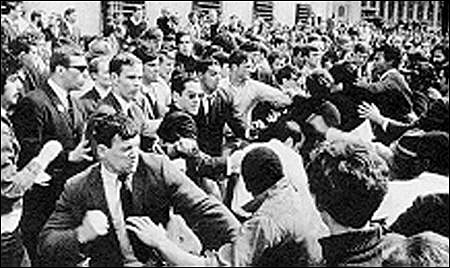 and
defiance demonstrations had become a collegiate entertainment as well. On April
30th the college administration decided it was not amused and called in the
police, who dragged students out of the buildings, beating some who are only
passively resisting.
and
defiance demonstrations had become a collegiate entertainment as well. On April
30th the college administration decided it was not amused and called in the
police, who dragged students out of the buildings, beating some who are only
passively resisting.
Police attacking students at Columbia U.
Mounted cops charged through campus striking out at any student in their way. Game time was definitely over. Many faculty were shocked, next day the campus was closed by a strike. It was a debacle in which both students and administration were tarred, but it also drew strong criticism onto the police, whose actions were seen as far too similar to those used by police in the South to beat down black civil rights demonstrators.
The Hippies were becoming the country's security blanket. No matter how you felt about them, their doings as presented in the print media and on TV provided sweet relief from racial warfare, burning cities, war protests and the Vietnam War itself. In fact, letters to the editor suggested that the media might even purposely be giving the Hippies too much publicity in an effort to distract the nation from the tidal wave of discontent. I believed it was quite possible. Some professional commentators wondered the same in magazines articles. And New York was about to enjoy a big swig of this soporific.
Hair re-opened on Broadway on April 29th at the Biltmore Theater, only a few days after the Columbia riots. (It ran from April 29, 1968 to July 1, 1972, closing after 1,742 performances.) It sang of sex and dope, black and white and, in a brief little musical package:
Sodomy...
Fellatio...Cunnilingus...Pederasty.Father, why do these words sound so nasty?Masturbationcan be funJoin the holy orgyKama SutraEveryone!!photo: Barry McGuire lead, and two other cast members
It came across with humor and irony rather than venom, and it applied its anti-war message beguilingly. At the finale members of the audience were encouraged to come up on the stage and dance with the cast in a kind of fashionable night out be-in. And the audiences did so enthusiastically, sporting their modish clothes, granny dresses, flower print shirts and love beads and doing the usual Hippie wiggle-and-sway to a medley of the rock score.
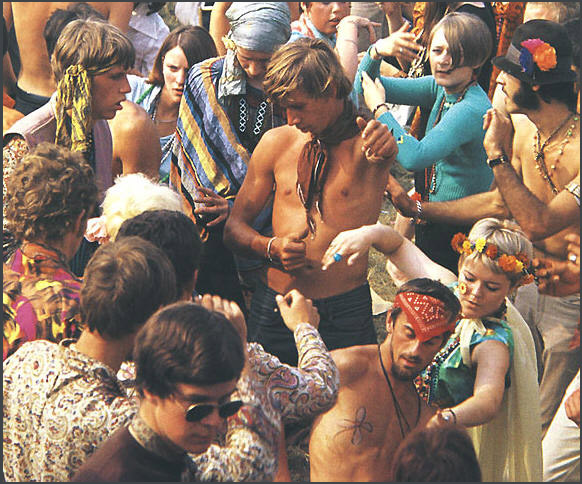 Bethesda
fountain in Central Park became a gathering place for Hippies, many of them
"Weekend Hippies" who trained in from the Long Island suburbs or walked over
from West End Avenue with their guitars. Hair, of course, and the ongoing
media celebration of anything it could call Hippie, encouraged the scene to
grow.
Bethesda
fountain in Central Park became a gathering place for Hippies, many of them
"Weekend Hippies" who trained in from the Long Island suburbs or walked over
from West End Avenue with their guitars. Hair, of course, and the ongoing
media celebration of anything it could call Hippie, encouraged the scene to
grow.
A group of what looks to be weekend hippies
The size of the weekend gatherings became worrisome to the city littering, drugs, the number of people and the wear and tear on the fountain area and the facilities nearby it looked to have the potential for degrading that area of the park the same way earlier gatherings had in Washington Square. And the Lindsay administration had been struggling to make the park appealing as a safe, refurbished retreat for New Yorkers.
This time the solution was not heavy police patrols and paddy wagons. It was a
"Hippie Cop." Or at least that's what he ended up being called: a young,
good-looking fellow, with somewhat longish hair and a previously very
non-regulation item, a mustache. He became the fountain area's personal cop,
strolling around, chatting with the young people and gently encouraging the
people to police the space themselves as much as possible. Later I heard from a
trustworthy source that he was gay. A few gay guys I knew from the neighborhood
checked out the Bethesda fountain on a couple of Sundays and characterized it
as "B and T." (Manhattanite slang for "bridge and tunnel," meaning people from
New Jersey, Queens and Long Island.)
"THE PEACOCK REVOLUTION"
Paisley shirt
 Male
New Yorkers, and certainly gay ones, were carried away in what had been dubbed
the "Peacock Revolution." By the latter part of the Sixties a hotchpotch of
styles filled store windows. From tacky shops around Times Square, to the big
merchants such as Macy's, Gimbels and Bloomingdales and a million "boutiques"
and enterprising neighborhood outlets
New Yorkers were loving that stuff.
Male
New Yorkers, and certainly gay ones, were carried away in what had been dubbed
the "Peacock Revolution." By the latter part of the Sixties a hotchpotch of
styles filled store windows. From tacky shops around Times Square, to the big
merchants such as Macy's, Gimbels and Bloomingdales and a million "boutiques"
and enterprising neighborhood outlets
New Yorkers were loving that stuff.
First, it was about...hair, of course! Men and boys of all ages were letting it grow long, longer and shoulder length...and many black men were ditching the straighteners, pressing caps and hair processing in favor "Afros."
Mod suit
 Some
of the men's clothes drew a line straight back to the "faggy" styles I'd first
seen in the Village Squire or Cromwell. Short rise, hip-hugging pants with no
side pockets, which were so tight it looked like they were being eaten by your butthole,
were a part of the scene. Aside from the fact that you had to have
snake-hips and a small ass to wear them, the legs were so narrow when they first
appeared that
they did not slide down again when you got up from sitting
creating the
impression as you stood there with your legs exposed halfway up your calves that
perhaps your butthole was succeeding. This style quickly acquired bellbottom
legs, but that did nothing to camouflage wide hips and a fat
Some
of the men's clothes drew a line straight back to the "faggy" styles I'd first
seen in the Village Squire or Cromwell. Short rise, hip-hugging pants with no
side pockets, which were so tight it looked like they were being eaten by your butthole,
were a part of the scene. Aside from the fact that you had to have
snake-hips and a small ass to wear them, the legs were so narrow when they first
appeared that
they did not slide down again when you got up from sitting
creating the
impression as you stood there with your legs exposed halfway up your calves that
perhaps your butthole was succeeding. This style quickly acquired bellbottom
legs, but that did nothing to camouflage wide hips and a fat ass. For gay men
there was one decided advantage to these pants, even a eunuch could not help
showing a basket and showing a basket was becoming more "in" than in the
late Fifties/early Sixties heyday
of meat rack cruising.
ass. For gay men
there was one decided advantage to these pants, even a eunuch could not help
showing a basket and showing a basket was becoming more "in" than in the
late Fifties/early Sixties heyday
of meat rack cruising.
Satin shirt
 British
Mod influence had come in with the Beatles. There were Edwardian suits, and
Nehru jackets, and like many of the men's styles the cut was extremely fitted.
Shirts were often open to the bottom of the chest, if not to the navel
given
that they were frequently extremely tapered, the skin-baring style
sometimes catered to
necessity as much as fad.
British
Mod influence had come in with the Beatles. There were Edwardian suits, and
Nehru jackets, and like many of the men's styles the cut was extremely fitted.
Shirts were often open to the bottom of the chest, if not to the navel
given
that they were frequently extremely tapered, the skin-baring style
sometimes catered to
necessity as much as fad.
The Hippie subculture was cannibalized with a
vengeance by commercial interests and the resulting products and styles Madison
Avenued to death. In dress the result was a kind of grab bag whose contents
suggested a joint convention of pirates and Gypsies
exotic fabrics (gauze was
popular,
and velvet and silk - rayon was a cheap substitute for silk, but it stunk if you
sweat in it), bright colors and floral prints and paisleys...plus cravats,
headbands, beads, scarves.
The
ubiquitous bellbottoms
 Bellbottoms showed up, and for awhile grew wider and wider until they culminated
in the "elephant bells." The search for "costume" type clothes, which may have
originated with the Hippies, led from your grandfather's trunk down to several new,
bare walls outlets in the East Village that had tons of what was called retro
clothing.
Bellbottoms showed up, and for awhile grew wider and wider until they culminated
in the "elephant bells." The search for "costume" type clothes, which may have
originated with the Hippies, led from your grandfather's trunk down to several new,
bare walls outlets in the East Village that had tons of what was called retro
clothing.
Only the caftan and some African styles spared out-of-shape, large and just plain fat folks from the indignities of clothes that fit like sausage skins.
And all of this was being embraced by straight guys! gay guys were just a part of the ride.
Nehru jacket/shirt
 If
Ken and I went to some straight environment, especially on a weekend night, the
crowd could look like a carnival scene
and the radical change in fashions did seem
to liven up the atmosphere. People were enjoying a sense of being "on
stage." But in the Candlelight Lounge you didn't see a wide array of these
styles on a Friday or Saturday night, though. Bellbottoms were popular, but
aside from some modish-looking shirts. Perhaps the Peacock Revolution gear was
at home in the
closet as this was still just a casual
neighborhood bar. However, many Upper West Side gay guys were working jobs
that didn't pull in big paychecks, and their purchase of faddish clothes may have
been very limited.
If
Ken and I went to some straight environment, especially on a weekend night, the
crowd could look like a carnival scene
and the radical change in fashions did seem
to liven up the atmosphere. People were enjoying a sense of being "on
stage." But in the Candlelight Lounge you didn't see a wide array of these
styles on a Friday or Saturday night, though. Bellbottoms were popular, but
aside from some modish-looking shirts. Perhaps the Peacock Revolution gear was
at home in the
closet as this was still just a casual
neighborhood bar. However, many Upper West Side gay guys were working jobs
that didn't pull in big paychecks, and their purchase of faddish clothes may have
been very limited.
THE DEMOCRATS' NATIONAL CONVENTION
"Not again. What is happening to us." I wrote this in a journal after Robert Kennedy was shot on June 6, 1968. I was at work when I heard the news, everyone was so shocked it was as if the building itself was holding its breath. He died the next day.
Kennedy was a Senator for New York State, and his funeral was held with great pomp at St. Patrick's Cathedral in New York City. The widows of President John F. Kennedy and Dr. Martin Luther King, Jr. were among the mourners. As the coffin was carried from the cathedral at the end of the service a chorus made up of lead singers from the Metropolitan Opera sang the Battle Hymn of the Republic. As Mrs. King stepped out of the building, someone called out to her that the assassin of her husband had just been captured.
Robert Kennedy had been running for the Democratic nomination in the presidential race. After his victory in California on the day before his death, it looked like he would be the favorite at the convention.
His death began a chain of events which over the next four years would alter the structure of the Democratic Party, destroy the base created by FDR in the 30's and weaken the party so badly that it has not recovered in more than four decades. The extent to which gay people and gay issues would ultimately play a part in this wasn't imaginable then, of course.
Kennedy's assassination left Sen. Eugene McCarthy in the race as an avowed anti-war candidate. The Vietnam War was proving to be such an enormous liability that President Johnson had announced that he was not seeking another term; whereupon, Vice President Hubert Humphrey had announced his candidacy, but did little active campaigning.
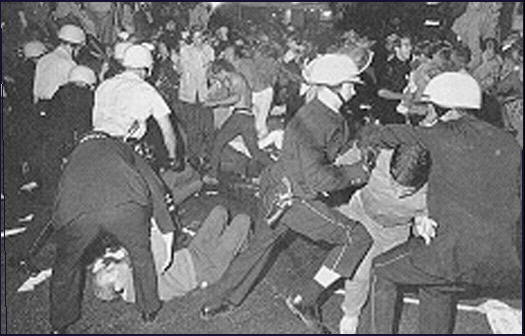 Although Humphrey now appeared the
favorite for the nomination, because of his support from the institutional
structures of the party which included traditional political bosses and their
machines he was an unpopular choice with many of the anti-war party members,
who identified him with Johnson's escalation of the Vietnam War.
Although Humphrey now appeared the
favorite for the nomination, because of his support from the institutional
structures of the party which included traditional political bosses and their
machines he was an unpopular choice with many of the anti-war party members,
who identified him with Johnson's escalation of the Vietnam War.
Chicago Convention police riot
Thousands of
protestors were in the Chicago, organized by the Yippies and anti-war groups. The
media and the nation
were shocked by television reporting of Chicago police
brutally attacking and bludgeoning these people in the streets while the
convention went on inside.
(right) Mayor Richard Daley
At the convention Chicago boss, Mayor Richard Daley, displayed a thuggish contempt for all. He was seen on television angrily mouthing obscenities at Senator Abraham Ribicoff, who made a speech to the convention denouncing the excesses of the Chicago police.
In the end, the nomination itself was anticlimactic, with Humphrey easily winning over Eugene McCarthy and Senator George McGovern (who served as a stand-in candidate for many of the Kennedy delegates, even though he had not run in a single primary during the campaign.)
It was not all tragedy, however. Gore Vidal and William Buckley (the latter one of the first "celebrity" high profile conservative journalists) were television commentators at the convention. Inspired by the proceedings, perhaps, they got into an on-the-air shouting match in which Vidal called Buckley a "neo-crypto-Nazi," and Buckley returned the favor, calling Vidal a "queer." Really, guys! this is national TV.
The Democrats' convention was a debacle, and the Republican candidate, former VP Richard "Tricky Dick" Nixon won the presidential election. Though the late Sixties are remembered for the peaking of anti-war sentiment, the reality is that 68% of the Americans who voted cast their votes for Richard Nixon or George Wallace both of whom supported the war, both of whom were hostile to contemporary liberalizing social trends. Only a third of the voters supported liberal politics and Hubert Humphrey.
By the
end of the year the total
number of US soldiers reported killed in Vietnam in 1968 was
about
14,000, the highest number for any year since U.S. involvement began.
"THE NEW FREEDOM"
When Dylan sang that the times were a-changing, even the New York Times was a-changing. It decided in 1968 that it couldn't stay mad in the face with Gore Vidal forever. It greeted Vidal's novel of the vengeful transsexual Myron/Myra Breckenridge with considerably more cool than it had City and the Pillar. It's reviewer wrote, "... the author's cheerful nihilism is suited to his outrageous theme: only a really queasy reader will fail to be amused (if not edified) by this satirical preview of doom in the making, by the anything-goes carnality. If Myra Breckinridge is not a succθs d'estime, it can justly be called a succθs de scandale. Once the word gets round, it will sell like popcorn at a double feature." And it certainly did. It seemed as if New Yorkers, and good number Americans in the trans-Hudson outback, couldn't wait to chortle or gasp over her tale.
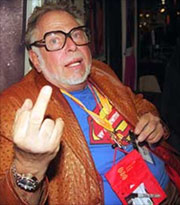 In
addition to Myra Breckenridge in the bookstores, Screw newspaper
appeared on New York newsstands in '68. It was vulgar, funny and raunchy, a mix
of explicit sex photos, humor
and articles that treated society's sacred cows as game animals. It also
contained a gay column, "The Homosexual Citizen"
a daring departure in those
days for a magazine aimed at straights.
In
addition to Myra Breckenridge in the bookstores, Screw newspaper
appeared on New York newsstands in '68. It was vulgar, funny and raunchy, a mix
of explicit sex photos, humor
and articles that treated society's sacred cows as game animals. It also
contained a gay column, "The Homosexual Citizen"
a daring departure in those
days for a magazine aimed at straights.
Senior Citizen, Al Goldstein, on his usual charm offensive, 2005
The editor, Al Goldstein, was arrested, as were several blind news dealers! Goldstein next took himself down to Wall Street with a corps of big busted women, who hawked the paper, calling out, "Get your Screw!" Screw didn't just fend off the censors, it triumphed and in a few months was selling over 100,000 copies on the city's newsstands and magazine stores.
Gore Vidal was quoted as saying he preferred it to the Times. Ah, revenge is sweet.
Goldstein was straight, but considered homosexuality just another part of the sexual scene. He hired gay people, and in an April 1969 issue ran a photo of two guys fucking the first time such a photo had been in a newsstand publication. He wrote: "We publish it as an example of the love between two people."
I found out (decades later) that in January 1968 New York State Judge Kenneth Keating had ruled that even close dancing between homosexuals was legal. This event is something that I have no recollection of whatsoever. I do clearly remember, however, that in the period right after this that dancing was still treated by bars as if it were illegal, i.e. - I knew of no licensed bars for the next two or three years that had public dancing. I can only guess that perhaps the cops ignored the ruling and that bar operators wishing to avoid trouble simply took no chances. However, my personal recollection is limited mostly to Stonewall and the Snake Pit, both of which were unlicensed (and thus illegal) premises and, therefore, it stands to reason that they would have continued to operate as before. (In 1971 the Exile had dancing, but again the place ran as an unlicensed, after-hours bar, so it still had a doorman, admission fee, etc. This points up the fact that changes in law enforcement and official attitudes subsequent to the Keating decision and the Sip-in had no effect on gay bars which attempted to operate without the required official NYS liquor license.)
 What
the New York
Times characterized in an article in 1969 as the "new freedom" in the arts,
was a reflection of the many changes percolating through the social, sexual and
political realms of American life. Dionysius in '69 produced down in
the Village, was an updated version of The Bacchae replete
with a conclusion in which the cast writhed in a naked fuck pile covered in
gore. It won the 68/69 Obie for the Performance Group.
What
the New York
Times characterized in an article in 1969 as the "new freedom" in the arts,
was a reflection of the many changes percolating through the social, sexual and
political realms of American life. Dionysius in '69 produced down in
the Village, was an updated version of The Bacchae replete
with a conclusion in which the cast writhed in a naked fuck pile covered in
gore. It won the 68/69 Obie for the Performance Group.
 Che!,
another
Village show, got closed due to complaints initiated by a clergyman to the
police. Che!, was a highly symbolic play based on the imagined last
hours of the Cuban revolutionary and dramatized the conflict between the United
States and popular revolutionary movements around the world. It contained
scenes of simulated sex, and what the Times sniffed at as "a number of
homosexual and other unorthodox sexual acts." It was closed by the police on
order of the court on March 24, 1969 (two days after it opened), and the cast
and crew were charged with consensual sodomy among other offenses. It was a
commie/fag thing again, but this time up on a stage saying, "Come and get me!"
a bit of a change from the Fifties. The cast resumed playing with their clothes
on while the case pended court.
Che!,
another
Village show, got closed due to complaints initiated by a clergyman to the
police. Che!, was a highly symbolic play based on the imagined last
hours of the Cuban revolutionary and dramatized the conflict between the United
States and popular revolutionary movements around the world. It contained
scenes of simulated sex, and what the Times sniffed at as "a number of
homosexual and other unorthodox sexual acts." It was closed by the police on
order of the court on March 24, 1969 (two days after it opened), and the cast
and crew were charged with consensual sodomy among other offenses. It was a
commie/fag thing again, but this time up on a stage saying, "Come and get me!"
a bit of a change from the Fifties. The cast resumed playing with their clothes
on while the case pended court.
The review Oh, Calcutta! a polished evening of "elegant erotica" cleverly took the Che! brouhaha as a cue. Its management invited members of city departments to attend previews in June, in order to unofficially advise on its acceptability for the stage. The publicity this generated couldn't have been purchased for a zillion dollars, and the play was a guaranteed smash before it opened. The show's producer, Hilliard Elkins, had last produced the 1964 musical Golden Boy, in which a black man made love to a white woman. There were complaints then about the interracial relationship. The race thing again. But the Fifties definitely were not doing as well in the Sixties.
Oh, yes. The police officer who investigated the complaint made against Che!, and then had to request the warrants of arrest from the court? It was Deputy Inspector Seymour Pine. Nineteen sixty-nine was not going to be his year.
 Boys
in the Band by Mart
Crowley had opened on Broadway in 1968, and Ken and I went to see it early the
following year. While I'd listened to its stinging put-down humor quoted with
great relish, I'd also heard some people say that it gave a repugnant picture of
gay men.
Boys
in the Band by Mart
Crowley had opened on Broadway in 1968, and Ken and I went to see it early the
following year. While I'd listened to its stinging put-down humor quoted with
great relish, I'd also heard some people say that it gave a repugnant picture of
gay men.
BITB Broadway cast
Whatever it was, it was being heralded in terms which indicated the press thought it was the first major play portraying homosexuals in a truthful way. Straights were loving it. (A bad sign, if there ever was one.) I didn't know what to expect. Though the audience was mostly straight, there were quite a few gay men in the house. Bitchy camp dialogue there was aplenty. The actor who played the main character, Michael, looked remarkably like Rob Manahan, the guy I had lived with in the Village as a college student, and the caustic humor which I did laugh at, with some discomfort could have been lifted from him and his best friend, Jim.
On the whole, however, the show was an uncomfortable look back over the shoulder as far as I was concerned. BITB presented an extreme picture of the world I came out into in the late Fifties especially in New York, and what I found among some men when I went to Cherry Grove in the early Sixties.
At the end, I applauded the great acting, and I applauded not a little because I was glad it was over. But I was angry and down because I felt it depicted the world of the Fifties as if it were the present, and typified present-day gay men by an anachronistic clique of pathetic and even vicious individuals.
On the way out of the theater, Ken said, "Thank God, it's not like that today."
I agreed. But I knew no matter how much I wanted to believe that, probably the play did spotlight wounds and scars that still remained. And would I have been so bothered if I hadn't been afraid that it showed something of me as well?Black life had made it to Broadway in Mamba's Daughters, and later Anna Lucasta and A Raisin in the Sun. But we'd gotten Tea and Sympathy and now Boys in the Band. We were definitely not doing something right!
However, the decade did close on a more positive note, when in 1969 the mainstream Midnight Cowboy opened. It starred Dustin Hoffman and Jon Voight, and won Oscars for best picture, best director and best screenplay, as well as best actor nominations for the two stars. The film tells the story of an inept hustler and his would-be manager, following their deepening relationship through the underside of New York. Though the film is harsh and gritty, it shows a relationship of caring and sacrifice. I think gay viewers, like myself, read a degree of "gayness" potential into the film's characters that may have been unintended by the writers however, if that is so, at least it was an appropriation of material a giant step closer to real life male-male situations than the old Hollywood he-and-she chestnuts.
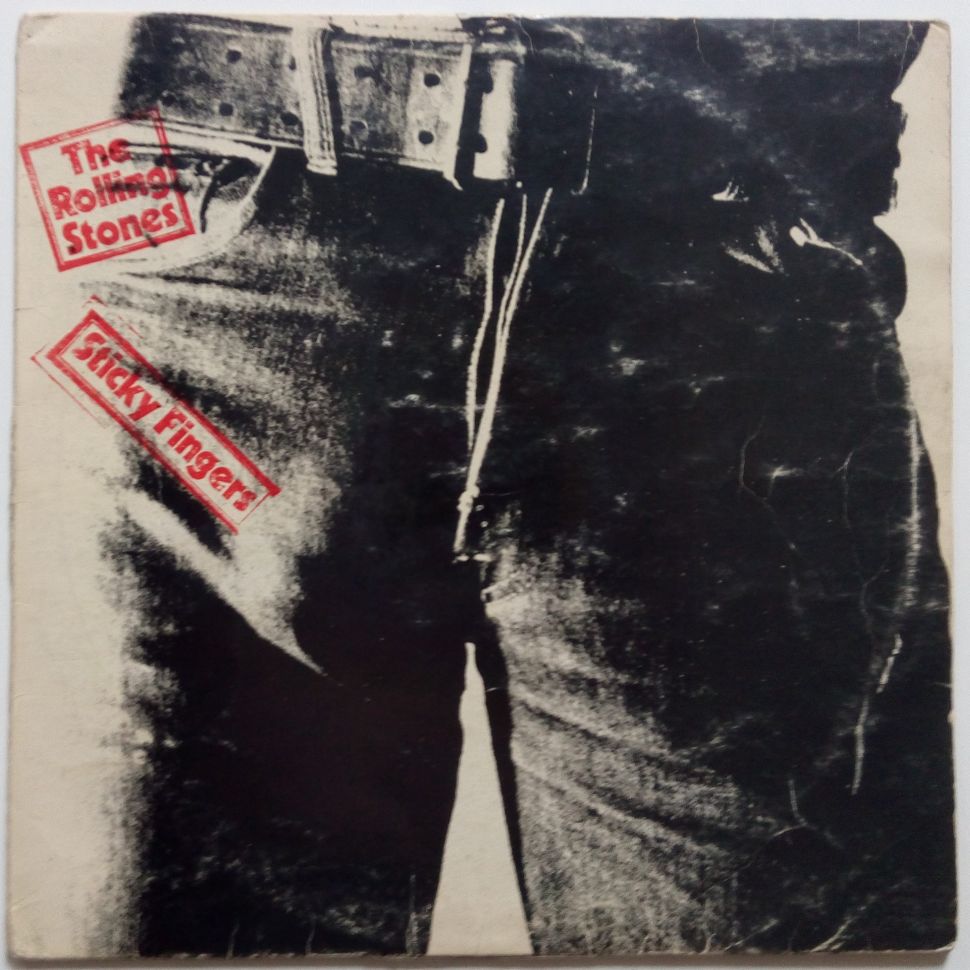
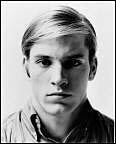 Paul Morrissey (increasingly the actual
creator of Andy Warhol's films) had given the world the real thing with Joe
Dallesandro in Flesh (1968) a day in the life of a hustler,
and Trash (1970.) Dallesandro was hailed as a "natural" and
"charismatic." And for some gay men the sight of "Little Joe" tattooed on
his arm stirred the embers of memory, bringing back his days as a physique
model for Bruce of Los Angeles and Physique Pictorial, when his moody looks and
smoldering love affair with the camera made him remarkable in a world of
self-conscious hustlers slathered in too much baby oil. The closeted
After Dark couldn't get enough of Joe.
Paul Morrissey (increasingly the actual
creator of Andy Warhol's films) had given the world the real thing with Joe
Dallesandro in Flesh (1968) a day in the life of a hustler,
and Trash (1970.) Dallesandro was hailed as a "natural" and
"charismatic." And for some gay men the sight of "Little Joe" tattooed on
his arm stirred the embers of memory, bringing back his days as a physique
model for Bruce of Los Angeles and Physique Pictorial, when his moody looks and
smoldering love affair with the camera made him remarkable in a world of
self-conscious hustlers slathered in too much baby oil. The closeted
After Dark couldn't get enough of Joe.
 In 1969 Colt Studios debuted in NYC, selling
drawings and photos by Jim French from a Greenwich Village P.O. Box.
In the early years the drawings struck me as a cut above the photos I
saw, but then the only Colt photos I ever saw (at this time) were not very professional prints
shown to me by someone who worked for French. French had begun the
photo sales as an offshoot of the drawings business, the first photos being
studies he made for his drawings. Perhaps what I saw might have
been this type of study and not the photos offered for sale.
In 1969 Colt Studios debuted in NYC, selling
drawings and photos by Jim French from a Greenwich Village P.O. Box.
In the early years the drawings struck me as a cut above the photos I
saw, but then the only Colt photos I ever saw (at this time) were not very professional prints
shown to me by someone who worked for French. French had begun the
photo sales as an offshoot of the drawings business, the first photos being
studies he made for his drawings. Perhaps what I saw might have
been this type of study and not the photos offered for sale.
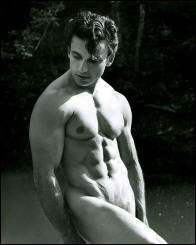
(right) Richard Bennett by Danny Fitzgerald
Prior this, in the early 60's a man named Danny Fitzgerald, working as Les Demi Dieux studios, had produced a body of work featuring young Brooklyn lads, which showed a consistent technical skill and sense of style very, very far removed from the usual beefcake photography. Nothing, as far as I was ever able to discover, was known about FitzGerald or his models. This was rectified in 2013 when two devoted collectors finally uncovered the story of his life, and found his original collection in the hands of his friend and best-known model, Richard Bennett. His photos of the very Italian-looking Richard Bennett whose real name may have been Richard Augelli remain some the most prized among collectors of vintage work.
Jim French possessed a similar skill
and style in even greater abundance (or perhaps he was simply lucky enough
to be working in kinder times, and, thus, more artistically favorable ones.)
And after his move to the West Coast, his work lifted beefcake and physique photography to a level of art
that for a time was virtually his exclusive territory
STONEWALL RIOTS
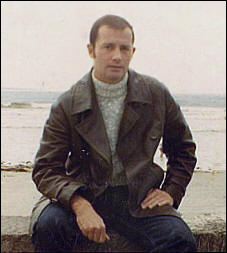 Saturday,
June 28th I'd just gotten back from vacation in Ireland and New York seemed broiling hot.
Ken and I decided to go to the Village for dinner that night
to the
Five Oaks, a small and popular downstairs place that got a mixture of straights
and gays. We came out of the IRT station at Sheridan Square somewhere between
nine and ten p.m. On the other side of Seventh Avenue, just a ways down
Christopher Street, we saw a crowd that was big enough to be spilling off the
sidewalk and into the street.
Saturday,
June 28th I'd just gotten back from vacation in Ireland and New York seemed broiling hot.
Ken and I decided to go to the Village for dinner that night
to the
Five Oaks, a small and popular downstairs place that got a mixture of straights
and gays. We came out of the IRT station at Sheridan Square somewhere between
nine and ten p.m. On the other side of Seventh Avenue, just a ways down
Christopher Street, we saw a crowd that was big enough to be spilling off the
sidewalk and into the street.
Me, Lahinch, Ireland June 27 '69
At first we were going to go over to check it out, but then realized that we were almost late for our reservations already and would probably end up standing in line if we took the time, so we went on. When we left we'd forgotten about the crowd, and we walked further west, anyway, rather than back to the square. Nothing seemed unusual for a Saturday night. What we had seen, of course, was the beginning of the second night of the Stonewall riots.
Wednesday night I stopped in the Candlelight, and someone asked me if I had heard about what happened in the Village. I hadn't and he told me that gay guys had been rioting with the cops. The next day I went through a stack of newspapers in the trash closet in the hall. I found a copy of the Times that had a small article on a far inside page, as I recall. It was an article in that very morning's paper, which covered the final disturbance which was taking place as I was first hearing about Stonewall the night before.
The raid on early Saturday morning had suddenly turned against the cops as they tried to hustle some of the patrons into a paddy wagon. The cops had to retreat inside the Stonewall, which the crowd outside tried to set on fire. Reinforcements showed up and rescued the cops. The next night crowds of men went on the offensive, taking over the upper part of Christopher Street, snarling traffic and at one point putting the cops at a dead run of retreat again. On Wednesday, the final night, outside radical groups gathered to see what the fairies were doing, and there was another brief riot, followed by some looting. Much of this night's hostile activity has been attributed to straight hooligans looking for a piece of the action.
An article in September 15, 1987 issue of The Advocate, "A Walk on the Wild Side" by Robert Amsel gives an account of those exciting days, as well as a helpful summary of events in the years just prior to them. This article appears in its entirety on many web pages, however, I am including it here again as, despite some errors, it is a decent overview if you if you haven't the time to read Carter's book. Though it may lack information which can be found elsewhere, it is also free of the inventions, outrageous fantasy and desperate need to be Politically Correct which mars many current web accounts of those events.
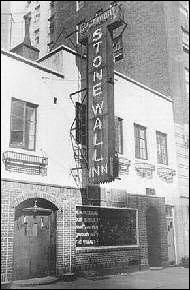 One weekend night in
late spring '67 I had gone downtown with Arthur and that gang to the
Stonewall, a new place they'd heard about. There was a line at the door, and I
got separated from them because I stopped to talk to someone I knew passing by.
As I got in line, I just saw Arthur disappearing inside. There were about four
guys ahead of me, I guess, and when I got to the door there was a book to sign
(this was sometimes done at dubiously run gay bars to give the impression that the
place was a private club,) and there was an admission fee too, of course.
Usually you got a ticket for your admission fee which entitled you to a drink. In
any case, one of the guys standing at the table asked if I'd been there before
whether I said "yes" or "no" I never remembered
but he immediately said, "You
haven't. This is a private club, you can't come in."
One weekend night in
late spring '67 I had gone downtown with Arthur and that gang to the
Stonewall, a new place they'd heard about. There was a line at the door, and I
got separated from them because I stopped to talk to someone I knew passing by.
As I got in line, I just saw Arthur disappearing inside. There were about four
guys ahead of me, I guess, and when I got to the door there was a book to sign
(this was sometimes done at dubiously run gay bars to give the impression that the
place was a private club,) and there was an admission fee too, of course.
Usually you got a ticket for your admission fee which entitled you to a drink. In
any case, one of the guys standing at the table asked if I'd been there before
whether I said "yes" or "no" I never remembered
but he immediately said, "You
haven't. This is a private club, you can't come in."
It was like, What!!? I'm gay, what do I need to have, wings? There was a guy standing at the table I recognized as having been a bartender at the Hatbox a few years before. I just started to say something to him, and the goons looked not happy including him, when Arthur stuck his head out the door.
"For Christ's sake, Mary, we're already inside. What are you waiting for!?
They looked at Arthur and asked him, was I with him. We both said, "Yeah!" in a one-word coloratura duet.
As I paid and signed, the guy who'd hassled me said, "I thought you were a cop."
A cop!!? I couldn't have been more surprised if he'd thought I was a giraffe. The cops want to arrest me because I'm a fairy, and now the Mafia wants to throw me out because I'm a cop. There was a serious disjuncture in this, to say the least. Later I decided that it was probably the fact that I had a conventional haircut and was wearing an old dress shirt with rolled up sleeves. In an era when lots of guys, and certainly gay guys in the Village, were wearing longish to long hair and bright-colored shirts, I probably did look suspiciously out of place rather than just your average fashion failure.
When I told Arthur about the mix-up, he looked at me with wide eyes, pressed a hand over his heart, and said in his most insincere voice, "My gawd! I'm sooo impressed."
That was one of the very, few times I went to the Stonewall on a weekend night. As the Candlelight Lounge in my neighborhood had a good weekend crowd, I usually stayed uptown on weekends. When a bunch of people from Fairfield shared a car back to the city we sometimes went down to the Village, and after leaving them I'd stop in at the Stonewall. Later on I don't remember any sign-in bullshit at the door, but maybe they didn't do it on week nights. Later on the Snake Pit opened nearby, west of Seventh Ave. at 211 West 10th in the basement. I preferred it to the Stonewall, which had the atmosphere, quite literally, of a subway toilet.
The Stonewall was a death-trap which had already suffered one fire. The bar had no running water to wash glasses in they were dunked in a bucket and came to you covered in the finger and lip prints of their previous users. The toilet at the back of the main bar was usually literally so awash in piss that the bar area stunk from it. Stonewall blatantly violated the law by serving watered booze, but that hardly mattered as the place had no liquor license.
It was also a Mafia dump. The police later said it was operated by the Gambino crime family. That seems unlikely as Tommy Eboli (aka "Tommy Ryan") of the Genovese family controlled gay bars and restaurants in southern Manhattan during the Sixties up until his death in a mob hit in '72. This fact was unimportant as far as the customers were concerned, gay men in New York took it for granted in the Fifties and most of the Sixties that all their bars were Mafia operations. The fact that the same ugly straight faces repeatedly drifted in and out of the bars in the gay scene made it credible. Ed Murphy, a goon who worked the door, was also a familiar face from former establishments but he had a private sideline which made him very dangerous to some gay men.
(I'm not even sure if the right of bona fide private clubs to serve booze to their members had been clarified in the courts at this point. I have a vague recollection that a place called the Gaslight Club (?), a straight private club, had been entangled in a court case a few years before this. However, the Stonewall was simply an unlicensed Mafia joint selling customers the house's booze by the drink, and in genuine private clubs the bottled booze had to be owned by the individual customers for their personal use.)
Dancing and a good juke box were the Stonewall's draw for me, and its convenient location by the IRT 7th Ave. subway line.
Over the years since the Stonewall riots occurred those events have been embellished with many fictions, among them that it was a gathering place for gay men and lesbians, that it was a bar for drag queens, and a place whose main clientele was black and Hispanic. From what I saw in the Stonewall none of these things were true. But despite the availability of reliable contemporary reports and interviews and the publication of an excellent book by David Carter, the Internet continues to proliferate invented Stonewalls tailored to present-day standards of Political Correctness.
An example of this was the now much-revised article in 2007 Wikipedia, Stonewall Riots, which contained in its introductory section the following claim.:
The Stonewall bar was heavily frequented by blacks and Hispanics. The decision by the police to raid the bar in the manner they did may have been influenced by the fact that most of the "homosexuals" they would encounter were of color, and therefore even more objectionable. A large percentage of the rioters were also men of color.
Dawn Hampton, a black employee at the Stonewall, is quoted in David Carter's book as saying that the bar's customers were Spanish, whites and blacks, but she added a qualifying emphasis: "...there were more whites than the others." Many other people familiar with the place have indicated the same in interviews, and the few photos taken outside at the time of the events show a majority of white faces, though undoubtedly some of these are Hispanic.
The Wikipedia phrase "heavily frequented" suggests to me something meaning a good deal more than half, perhaps two-thirds or even more. If the phrase was intended to mean that by the person who put it in the article, based on my observations as a customer, it is dead wrong. Like the Candlelight Lounge customers on the Upper West Side, the Stonewall crowd was somewhat racially mixed, though much more ethnically mixed. My recollection, like those of others who went there, is that blacks were always the smallest percentage of the crowd, by far most customers were Hispanic or white and to the extent that one could tell from appearances the majority were non-Hispanic whites.
Significantly, I think, I never heard the Stonewall characterized by white gay men as being "black" or "Hispanic." In an era when bars were usually given capsule descriptions that characterized their patrons, I think this should dispel any lingering doubt. To comment as the Wikipedia article does that "most of the "homosexuals" they [the police] would encounter were of color" is completely and wildly at odds with the facts.
And the remark about "raid the bar in the manner they did" (emphasis added) is puzzling. The descriptions in the two books about the Stonewall riots and in other accounts don't indicate that there was anything out of the ordinary about the manner in which the raid was initiated (though the results were certainly out of the ordinary!) The author(s) of this earlier Wiki article would seem to have been unfamiliar with NYC gay bar raids in the Fifties or Sixties. Raids on the Snake Pit and the Zodiac, two other unlicensed gay places, were conducted in the same manner. Granted, most bar raids did not always scoop up customers and cart them off in the Paddy wagon, usually only the staff got that treat. Serious police raids, however, were something else again, and they had not turned into love-ins, despite the Summer of Love and Woodstock.
The Stonewall events are fine as they really were. It was not a politically correct theater piece just waiting for opening night.
The Stonewall was a sleazy slice of New York underworld life. In the Flower Power Sixties, behind the Stonewall's front door there was still a bit of Gotham in the Fifties: the crowd and the atmosphere a blend of old dance bars like the Grapevine and the 415, a mixture that must have had Lee Mortimer spinning in his grave like a windmill. It was a New York crowd, replete with Mafia lightweights and a closet gay, ex-con blackmailer and it's a New York story that could have inspired a gay Damon Runyon or provided some of the real-life New York material for a novel in Lawrence Block's Scudder series.
But it was the Sixties, the end of the Sixties at that. Freedom fever was loose, and by this time even gay people understood: their enemies were not invulnerable.
Weekend nights the Stonewall was packed, and often uncomfortably so. On week nights the bar crowd was slack, and the inside room off the main bar was usually the more crowded. I can recall rarely seeing anyone in full drag. If I dropped in late after work once in awhile I'd be in a sport jacket or even a suit, which was its own kind of conspicuous het drag. I would take off the tie and stick it in a pocket and unbutton the shirt a bit in an attempt not to stand out quite as much. I never took off the jacket. I had once hung up a sweater on a hook on the wall, and at the end of the evening found it had been stolen. I was naοve, I guess, but in the Candlelight most customers threw their jackets and heavier clothes in a huge pile in the same booth, and for years theft was unheard of. The Old Vic had proved to be a similarly safe environment. I had wrongly assumed that the Stonewall was the same type of gay place. It wasn't.
I never saw anyone else there in my kind of office monkey suit, and I wonder where the "tweedy East Siders" were that Martin Duberman refers to in his book Stonewall. Never saw any there. The place was a mixture of guys in their twenties, wearing a variety of informal clothing styles. There were always a few "slap queens" or "face queens," guys who wore some makeup, longish fluffed out hair, and colorful blousy-looking shirts a kind of semi-drag. A few guys looked extremely young, and I used to wonder if they were eighteen yet. I don't recall ever seeing any women customers in the place when I was there.
One night, though, I was there after leaving the kids from work, and a drag was there in a deep green satin-looking evening gown with black netting over the skirt, or maybe the fabric was green-black jacquard. She was also wearing jewelry and, I think, maybe a headband in her hair. I was dressed in a suit, because of a company conference or something. It was inevitable as the accidental formal "couple" in the place that we shared a dance. It was not a crowded night, but as we started to dance the two or three other couples on the floor moved to the edge of the floor or stopped, and we this oddly out-of-place night club couple became the entertainment. I was excruciatingly uncomfortable being a terrible slow dancer and now people were watching. Our conversation was as stiff as my dancing, and at the end she said, more kindly than I might have expected, "You're not a very good dancer, are you?" A long fall for someone who had begun his Stonewall career as a suspected cop!
That was the end of that, until several years later, when I saw a photograph of Sylvia Rivera. I was certain she had beenthe "lady in green," the sharp features, long face and nose and the intense eyes were instantly familiar. I'd had maybe a three minute portion of my fifteen minutes of fame.
One night in '68 (or maybe early '69) I came in and the front bar was empty. The guy I'd recognized from the old Hatbox bar on Herald Square on my first night was alone at the bar, and wearing a really sour look on his puss. The bar area smelled foul. I ordered a beer. It was warm. He was in a rotten mood, so chit chat died real quick, and I just watched him "washing" the glasses dipping them in a bucket of water, rinsing them and lining them up on the bar. A couple of times he held one up to look at it in disgust. The finger prints and lip prints could have been seen all the way to Yonkers. The glasses were filthy, as they often were when you got a mixed drink. I went to take a piss, and the bathroom floor was covered in urine and the toilet bowl was overflowing with a turd and wads of toilet paper. The place was a hole, but this was the worst I'd ever seen it.
The other room had a small crowd, and I leaned against the wall drinking my beer. I watched one of the slap queens moving slowly along the wall of hanging coats, slipping her hands into the pockets as she eyed the room. I'd seen her or someone similar doing the same thing other nights.
I really got a hair across my ass about the place that night: the dirtiness, the smell, the lousy warm beer along with the pickpocketing and coat-stealing the whole nine yards. And I gave it the kiss-off.
After this when I wanted to dance, I went to the Snake Pit. It was in a dingy basement and a fire trap too, but it was cleaner, it also had a good juke box and the crowd was much friendlier with no reputation for drugs and pickpocketing.
Martin Duberman
authored the first book on the Stonewall riots, which came out in 1993. Some
people were very critical of the first edition, claiming that his personal
biases and grudges influenced his writing, and that he made factual errors.
Graffiti on Christopher St. after the riots
I read it back then, and while I was grateful that someone had finally tried to nail down these important events for history, I was lukewarm about his results too. He spent, in my estimation, entirely too much time on the doings and machinations surrounding obscure gay homophile conventions and personal rivalries, etc. in the pre-Stonewall years. He also presented, I felt, a very lopsided impression of New York City gay life in the few years just prior to the riots. What must be taken into account is the fact that during those years, and even after Stonewall, Duberman as he presents himself in his autobiographical book Cures, was a self-loathing gay man looking to go straight. No way, I think, could this man have an accurate picture of New York gay life in those years.
Duberman in Stonewall presents the stories of six individuals he called "the cast," and had these converge in the events of June 1969 and the year following. This device may owe something to his brief secondary career as a playwright. He wrote in the introductory material to his book, "I have deliberately chosen people whose stories were in themselves absorbing odysseys, and yet could at the same time speak to other gay men and lesbians." In the same section he says, "Their stories were different enough to suggest the diversity of gay and lesbian lives...."
Bullshit.
Despite the "diversity" buzz word, not one of his "cast" is representative of the many thousands of ordinary gay men (and lesbians, I'm sure.) The ordinary gay people who were leading what would now be called "out" lives, creating gay lives that were public, pushing on the barriers they encountered in their lives and taking advantage of the currents of change in Sixties; and most challenging, doing this in the environment of the work world. (At this time all of my close friends plus myself European-Americans, Hispanic and black were out at work and in their lives in the neighborhood. Only with parents did some still try to pass as straight.) Even as New York gay life was undergoing the oppression of the Wagner years, many gay New Yorkers were still actively seeking the much vaunted freedom that the City had always promised the hick, the outsider, the foreigner, the outcast. Manhattan gay life in the mid and late Sixties was not the sound of clanking chains in dismal alleys, it was coming alive through stick-to-it-iveness and getting a public face again. Furthermore, most of the gay men I knew, despite the ordinary ups and downs of life and the extraordinary ones that being gay put in your way were upbeat people.
All these are the gay people that Duberman's "cast" does not represent, and the tone of life that his book misses entirely. This omission seriously distorts his picture of those times in the City, and it is a major, major failing. Duberman's effort has been eclipsed, fortunately, by a far better, and credible historical work on Stonewall.
This book, Stonewall, The Riots That Sparked the Gay Revolution by David Carter, came out in 2004. Carter's is a much more tightly focused book than Duberman's, and also looks to be the result of more and much better research and analysis. His closing chapter, "Conclusions," strikes me as a very thoughtful one. He also seems to have successfully weeded out a few dubious self-promoters who have attached themselves to the history of those days.
Carter's book pays close attention to what he calls the "street kids" around the Stonewall scene, and he draws heavily on the written records and memories of homophile activists of the era. But both of these groups were only a very small part of New York gay life, especially the latter, which were a miniscule presence. Concentration on these two groups (which is understandable, perhaps, in the Stonewall riot context) may help to explain why even Carter's book seems to ignore the extent to which NYC gay life had been coming out of the doldrums.
I have never seen the Stonewall riots as the beginning of Gay Liberation in the city, if you lived in the city then you knew that it was already underway. To me the Stonewall events were something more on the order of a defiant celebration of the changes in New York gay life.
After-hours bars and phony "private clubs" in New York not only violated the State liquor laws in regard to licensing, more importantly, perhaps, they were usually overcrowded firetraps that ignored the safety laws as well. Periodically the proliferation of illegal drinking establishments was wiped out by the police and fire departments in a barrage of raids and summonses.
This continued to be the pattern in NYC through the rest of the 20th century. "Clubs" selling booze to customers without a license from the State of New York were, and are, illegal no matter who the patrons are. In 1975 seven patrons of the Blue Angel, a legal nightclub, died in a fire. More stringent codes were enacted to insure public safety in legally operated nightclubs. For those who choose to operate clubs outside the law, the FDNY deploys a Social Club Task Force comprised of fire marshals that vacate and padlock these premises. Despite this, eighty-seven people died in a fire in 1990 at the illegal Happy Land Club in the Bronx which catered to Hispanics)
Hispanic nightlife in New York thrived on clubs many of them illegal operations. And I had known of similar clubs run by Italians, and of course, they were cropping up in the gay scene. In Spanish Harlem and the South Bronx such establishments had been recently raided and closed. The heat was on illegal "clubs."
Stonewall existed on a
well-lit public thoroughfare and was highly visible at the upper end of
Christopher Street. That it would have been a prime target for closing in any
drive against illegal and after-hours bars is not surprising. Perhaps, as has
been alleged, the management had been giving payoffs to police officers, but
this kind of "insurance" only postponed the inevitable. Eventually some
political pressure or action within the police department would arise which
caused the corrupt cop to duck and run, and the jig was up.
However, the Stonewall riots proved to be a shocking exception to the rule that these places died a silent death.
Inspector Seymour Pine
Probably Inspector Pine's biggest mistake might actually have been a tactical error to make this raid on a Saturday morning when the club would be full and the streets would still be fairly well trafficked. The same action on a week night might well have gone unprotested by a handful of customers and attracted little attention on the street.
During the years of school integration and civil rights demonstrations the police in the South had often set upon the marchers with attack dogs, truncheons, fires hoses and tear gas. And the photos were seen by the entire nation. What the Walker Report to the National Commission on the Causes and Prevention of Violence termed the "police riot" at the '68 Convention on Chicago and the brutal attacks by the police at Columbia University were further examples, in Northern venues, which shattered the old image of "the policeman is your friend." It was seen that the police were not always there to preserve the peace, but were perhaps just as often there to preserve those in power.
Public protest and civil disobedience had become commonplace in the campaigns for racial equality and the growing anti-war movement. And while the Hippies may have inspired thumbing your nose at social conventions, the total collapse of public order in many cities across the nation for several summers in a row pointed to more extreme actions. Police violence at the Democratic convention in Chicago and at Columbia University worsened the climate.
NYC gay life was recovering from an era of repression and harassment which had lasted from 1959 until the end of the Wagner mayoralty, and had seen the Lindsay administration support the first official rollback of anti-gay measures in city history. That the police force rank and file hated Lindsay and his liberal agenda was part of the new picture too, and confirmed the negative view of the police born in the events of the preceding years.
One unsupported and unfootnoted assertion by John D'Emilio in his 1983 book, Sexual Politics, Sexual Communities, doesn't seem a very credible speculation now. He wrote regarding the Stonewall raid: "New York was in the midst of a mayoral campaign - always a bad time for the city's homosexuals - and John Lindsay, the incumbent who had recently lost his party's primary, had reason to agree to a police cleanup." He also alludes in the next sentence to a recent action of "initiating a series of raids on gay bars" by the Village police precinct prior to the Stonewall raid.
The so-called "cleanup" going on at the time specifically targeted a small group of Mafia run bars. And it was being conducted by the First Division Morals, which covered all of southern Manhattan from Midtown to the Battery, not by the Village 6th precinct. These bars were suspected of being the base for an extortion ring which was connected to the theft of bonds. If any consultation with the Lindsay administration took place, it would be unlikely, given that this was not a major anti-vice campaign, that it would have gone any higher than Police Commissioner Garelick at best.
What was involved was not a matter of city-wide policy, but rather a concerted series of police actions focused on a single crime problem. I do not recall the bars we thought were non-Mafia being touched, and David Carter does not name any of them in this connection in his book, though he does list three Mafia bars in the Village.
The currents of change which preceded Stonewall determined that a Stonewall could happen.
It was against this background that Inspector Seymour Pine moved on the Stonewall. (And later the illegal unlicensed Snake Pit, where one customer, Diego Vinales, almost died after hurling himself from the window of the police station.) Given the new taste of personal freedom, plus the national currents of anger and protest, and against the police in particular, it was not surprising that the lid blew off.
The Stonewall riots in June 1969 are taken on a national and worldwide level to mark the genesis of Gay Liberation. However, that interpretation doesn't fit the history of gay New Yorkers. In mythic terms Stonewall is a benchmark for gay people but in terms of the everyday life of gay New Yorkers Gay Liberation had already been visibly and legally underway since the Sip-In of early 1966. And even before that in the life of every gay person who was publically out in their social and work life.
The weekend following the first Stonewall riot customers in the Candlelight were asking, "Did you hear what happened in the Village?" Within another week it no longer came up. It's hardly surprising, I think, considering the tumultuous times, that the events connected with the Stonewall raid did not command more intense and sustained interest among the Candlelight Lounge patrons. Gays resisting the police was truly remarkable...but resisting because of a raid on an unlicensed stinking Mafia shithole? When gay people can legally drink in any licensed premises?
August 15th was the beginning of the Woodstock festival, and as the event grew
and grew and grew, I kept checking the radio in disbelief. Eventually it
became an encampment of 400,000 people. Even though I didn't identify with
the Rock culture it was still exciting, and I did wonder if it had attracted
many/any gay people. Later two gay guys I knew said they had gone, and
while they had a good time and no hassles, one described it as, "As straight as
Christmas with your parents." When I finally saw the documentary film it
was the amazing event rather than the music that interested me, although the
closing scenes of acres and acres of beautiful countryside turned into a wallow
of trash and debris was a complete bummer. Still, it was an event that ranked with the Summer of Love.
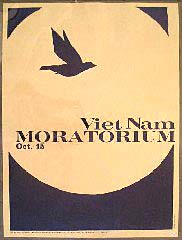
October 15th we marched in the Vietnam Moratorium, where we saw many other gay men. In New York Mayor John Lindsay had ordered the US flag to be flown at half-mast for the day, though police officers and fire fighters drove with their headlights on in protest against the Moratorium day - as did many ordinary American citizens. However, the Moratorium for the first time brought out America's middle class and middle-aged voters onto the streets in large numbers. This anti-war demonstration was a moving experience for me: The war was being fought with white working class and rural boys and young black men, while sons of wealthier white Americans stayed in college or fled to Canada. Police antagonism seemed to me to be exceptionally high and puzzling, considering the class origins of many policemen. It brought up again how much I had learned to live in fear of the police, and how far I had come from the comfortable childhood days when the policeman was your friend. And the difference between the heritage of President Roosevelt and WW II contrasted mightily with the images of the beleaguered, weary Johnson and Nixon and the manufacture of deceit for public consumption. The Vietnam War was creating a cynicism in me for authority and my government in a way the more personal anti-gay events of my life in Syracuse and New York had not.
Incidentally, Allen Ginsberg, the gay poet, was a prominent figure at anti-war rallies and demonstrations.
In a miserable final spectacle the Hippie/youth/love fantasy trip and the media hype attending it came crashing to the ground on December 6th at a Rolling Stones' concert in Altamont speedway in California. In a concert plagued with fighting and thuggishness, the Hell's Angels, hired by the Stones as security, beat a man to death in front of the stage in full view of the Stones and the audience. Three others died there in accidents.
The media now felt free to kiss off the Hippies. They were no longer amusing, much less a salutary distraction.
The year ended sourly. Ken and I took a vacation to St. Croix my first to the Caribbean, and one I had pinched many pennies to afford. Twice while we were there we were the object of anti-gay hostility, once from a man driving by and again from a woman in a store. That both antagonists were black didn't mitigate the humiliation and anger though I kept feeling that it should but it had the effect of discouraging me from assuming the existence of automatic solidarity with other traditional recipients of hatred. I didn't forget these episodes. Later when I began working at the Central Office of the City University I encountered overt anti-gay hostility from some of the clerical and service level black employees. I was very up front, your skin color doesn't give you a pass I don't give you shit, don't you give me shit.
I LOVE A PARADE
The straight, mainstream newspapers, and gay scuttlebutt, were the main sources of information. And one early impression was that the Stonewall riots however dramatic they may have been in terms of the-worm-turns were a reaction/protest over the attempted closing of the Stonewall itself. But I don't recall any of the guys I knew going down to the Stonewall on a regular basis, and it had a reputation as a dirty, unlicensed Mafia dump so, who cared about the Stonewall itself if they didn't hang out there?
It was the kind of illegal dump that the Sip-In of '66, followed by the SLA retreat and the subsequent court actions, was supposed to be making unnecessary in gay life.
A few years later when an article denigrated Stonewall as the symbol of gay liberation because of what the place itself was, Marty Montford, the president of the Gay Activist Alliance, made a point of saying, "...it was virtually all we had." This was absolutely NOT the case.
There were openly operating gay bars that the police didn't raid. Aside from the Candlelight uptown, there was the Old Vic, Kellers, Julius's, International Stud and I and at least one other person think that the famous Triangle bar had just opened. All these were legally licensed bars, the last four were in the Village. (And there was the unlicensed Snake Pit on 10th Street too, another unlicensed one in a basement on West 4th, and for awhile there was a gathering place that didn't serve alcohol for gays under the legal drinking age, the Tenth of Always though I'm not sure whether it was still open in June '69.) There certainly were alternatives to the Stonewall, and what is more, there were legal ones.
However, as Montford went on to say with more accuracy, the importance of the Stonewall riots was not that they were at the Stonewall Inn, but that they were directed against the police and beyond them, at the oppression of the state and the society they served.
For me, at least, gaps followed in any news related to the aftermath of the riots. It was not until 1969 that there were gay newspapers in the City. Gay was the better one, and had been started by Al Goldstein, the straight editor-publisher of the infamous Screw newspaper. Goldstein, an ardent anti-authoritarian, funded the start-up costs of the paper. The other was called Gay Power and tended to be a farrago of wild-eyed rhetoric.
These papers were distributed in other parts of Manhattan besides the Village, but the problem was finding them. It wasn't that no one wanted to stock them they were prominently displayed in the newsstands around the 72nd IRT subway stop, and a magazine-card shop a block up 72nd from our apartment displayed them in front of the cash register with the ethnic weekly papers. So, they were there for about five minutes! They sold out in a flash. I asked the magazine store clerk why I never saw Gay there when other people said they did. He told me they only got a very few copies and these sold out within half a day. As I worked in the suburbs I was gone by the early a.m. and didn't return till after 6 p.m., which seemed to keep me out of the running. In their beginning period I usually only saw either paper if someone else I knew happened to have bought a copy.
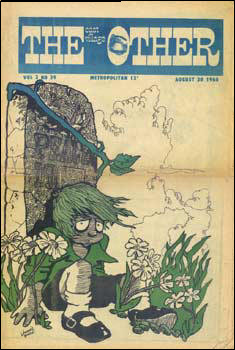 There was, however, the alternative press which had sprung
up. The most popular and best-remembered was EVO, the East Village
Other, which had started in late '65. Another was called Rat. They began picking up on some gay
news, and EVO was easy to get.
There was, however, the alternative press which had sprung
up. The most popular and best-remembered was EVO, the East Village
Other, which had started in late '65. Another was called Rat. They began picking up on some gay
news, and EVO was easy to get.
EVO, August '68
A more frequent and certainly more colorful source was Miss Ellen, the Mouth of the South, who claimed to have a "daughter" in the Gay Liberation Front (GLF.) It was hard to know what to make of Miss Ellen's reports of GLF doings. That they were intended to entertain there was no doubt, but jeez! were they true? Her editorial comments were hilarious, but her stories of what went on in their meetings sounded like a parody of China's notorious Red Guards. My initial reaction was to take her reportage with more than the proverbial grain of salt a tablespoon, perhaps. I began to wonder if this purported "daughter" even existed, or was she just a device for spinning out comic monologues.
Miss Ellen had a special affection for "the ladies of STAR," (Street Transvestites Action Revolutionaries), as she called them.
The core fact was that GLF was a group of young gay people, dissatisfied with the tactics of Mattachine and even its attempts to take a more forceful direction, who had renamed their faction in mid-summer and struck out on their own.
The bits and pieces I picked up from the alternative press through the fall did bring me to the point of a few silent mea culpas where doubting Miss Ellen was concerned. GLF invoked all the by now familiar clichιs and rhetorical excesses of the extreme Left. Over a few months I got the impression that their principal goal was to be a gay copy-cat of the radical SDS (Students for a Democratic Society.)
The zinger came in the early winter. The Gay Liberation Front had voted a cash donation to the Black Panthers virulent homophobes of the worst stripe, but big players in the alternative world of radical Left politics! Miss Ellen stammered to a halt when she tried to talk about it in my living room, and then just shook her head.
What I saw at that point was a bunch of young gay, wannabe radical Leftists so desperate to play with the Big Guys that they would bribe some of the worst of the homophobes for a space in the playground. And then there was Castro who at the time was rounding up gay people and putting them in detention camps yet some of the GLF'ers were ardent Castro supporters.
These GLF people weren't gay liberationists, they were desperate quislings!
 I refused to read anything about them, or anything at all
about gay political doings in the Village. As a result, I missed the formation
of the Gay Activist Alliance (GAA) founded by people who found GLF suckholing gay-haters repugnant.
I refused to read anything about them, or anything at all
about gay political doings in the Village. As a result, I missed the formation
of the Gay Activist Alliance (GAA) founded by people who found GLF suckholing gay-haters repugnant.
Jim Owles, GAA founder
A Cuban acquaintance had such venomous hatred for these GLF people that he would blew his top if their name was even mentioned. (Much later I learned that upon the rapid disintegration of GLF a couple of its members did what might be described as "missionary" work, traveling to college campuses to spread the word. The GLF organizations that were founded in these places, from the very little I have heard and come across on the Internet over the years, evidently were on the whole more hardheaded, practical groups than the NYC original.)
Like many gay people at this time, I had found the affairs of the local Democrats increasingly interesting. Carmine DeSapio, the last Tammany Hall boss, had fallen in the early 60's, and the Tammany Hall machine was defunct by this time. DeSapio had been part of the shift in leadership of the NYC Dems from the Irish to the Italians, and the Reform Democrats who followed him was an ascendancy of Jews, allied with upper class, liberal Protestants, to power. The new breed of Democrat was represented by Ed Koch, Bella Abzug and the Afro-American Shirley Chisolm people whose liberal stance included pro-gay positions.
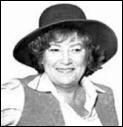

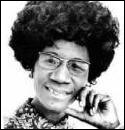
Bella Abzug, Ed Koch, Shirley Chisholm
When I had become old enough to register to vote, twenty-one at that time, I had registered under the Liberal Party. The Liberal party, in U.S. history, was a political party formed in 1944 in New York City by a group of anti-Communist trade unionists and liberals who withdrew from the American Labor Party when that party became pro-Communist. The original party platform called for a strong United Nations, extended civil rights, and support of the American trade-union movement. Rather than attempting to elect its own candidates, the Liberal party generally sought to influence the candidate choice of the major parties by promises of support or nonsupport. Although the party operated almost entirely in New York state, its endorsement of presidential candidates was occasionally significant.
The Liberal Party provided the key support in Franklin D. Roosevelt's 1944 victory in New York State. In 1960, the party's 406,000 votes for John F. Kennedy provided his margin of victory in New York State, and the state's 43 electoral college votes ultimately provided his national margin of victory. John Lindsay, a Republican, had also received Liberal Party backing for mayor when he won in 1966.
The raid on the Snake Pit, an illegal gay bar on West 10th, on March 8, 1970 received more coverage than Stonewall. The horrific accident when one of the gay men taken to the Charles Street police station was impaled on the points of an iron fence when he threw himself from a window; and the subsequent protest and vigil, made a bigger impression than the Stonewall riots had among the people I knew. The ghastly picture of Diego Vinales impaled on the fence was the front page photo of the Daily News, so it wasn't just gay New York that shared the horror of it.
Looking at the incoherence of the radical Left, and the self-evident groveling treachery of GLF, the liberal politicians of the traditional parties would seem a more promising option especially given the currents flowing through the Sixties. Lindsay, though a Republican part of that party's then existent liberal wing was popular, of course, though liberalism in the GOP was an endangered species. For me, and as it turned out for most other gay New Yorkers, the Reform Democrats looked like the vehicle that could and would effect gay rights changes in the laws. In the long run, this was the winning card.
The first gay parade in the city the 1970 commemoration of the Stonewall riots of the previous year occurred without me being aware of it. I have no recollection of hearing about it beforehand, nor have I ever come across any mentions of it in any journal or memorabilia of mine which leads me to the conclusion that I didn't know about it.
This isn't as unlikely as it might sound nowadays. Again, there was the problem of getting your hands on a gay paper in my neighborhood. In addition, the Candlelight Lounge had no bulletin board, nor to my knowledge was there any attempt by a gay political organization to pass out any flyers or info there. I was sometimes going down to the Triangle bar at West 14th and Ninth Ave. in '70, but have no recollection of hearing about an upcoming event. (However, I assume that if I had been actively following activities of GLF, and the new GAA, these would have included stories of the impending march - although I've never seen copies/clippings of any such stories from that time.)
But, I believe, something less obvious was at work too the West Village was no longer the center of gay life the way it had once been. The gay population of the Upper West Side (and the East Side too) was considerable. The weekend crowd at the Candlelight was now packed in like a subway car at rush hour. My own trips downtown had become infrequent, and evidently a fair number of other guys were not hopping on the bus or train for the Village either. The vital word-of-mouth that was a kind of gay "jungle telegraph" may no longer have been working quite as well as it had. Gay life began to show two rather contradictory currents. First, as bars proliferated, the sense of gay neighborhood developed in more places than the West Village. But, at the same time, gay bars all over town began to sprout bulletin boards or allowed notices on the wall, and you found stacks of handouts on the top of the cigarette machine, gossipy "bar rags" appeared and more and more gay publications hit the newsstands.
In other cities and the hinterlands certainly, (and eventually in other countries) where anti-gay oppression was very harsh, and the Sixties winds of change hardly more than a breeze, the story of the Stonewall riots and the burst of activism afterward must surely have seemed little less than a direct beam from the torch of the Statue of Liberty. But in the city the Stonewall riots quickly receded from view, GLF soon vanished and GAA lasted only a few short years. The activist groups that arose in New York provided a short-lived vehicle for younger gay people who were nostalgic for or perhaps had just missed the stormy hoopla of student radicalism. But without a doubt they also provided a positive influence which promoted self-esteem for younger people, who were struggling with coming out as I had been beginning in 1958 and through the early Sixties but with zero positive encouragement. And, yes, GAA did score some good publicity points. However, all the winds of social, cultural and political change had been gathering strength in New York for years, and the Stonewall riots were only one part of the culminating storm.
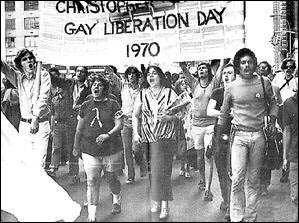 I've never felt that
the Stonewall riots themselves - unlike the Sip-in or Mattachine's bargaining
with Mayor Lindsay over police entrapment or fair employment
had any direct
positive impact on my life as a gay man or altered it in any
significant way for the better. In 2006 I asked a neighborhood
friend of mine from those years, someone who would have been just in his
mid-twenties at the time, if he felt that the Stonewall events had any influence
on his life, and he said, "No." However, again, as was the case with the
other guys in our group, he was already out to his parents, to his neighbors and on his
job. But I recognize that for younger people struggling with coming out, and anyone still
in the closet the events at the Stonewall Inn could have had a seismic effect in
their lives.
I've never felt that
the Stonewall riots themselves - unlike the Sip-in or Mattachine's bargaining
with Mayor Lindsay over police entrapment or fair employment
had any direct
positive impact on my life as a gay man or altered it in any
significant way for the better. In 2006 I asked a neighborhood
friend of mine from those years, someone who would have been just in his
mid-twenties at the time, if he felt that the Stonewall events had any influence
on his life, and he said, "No." However, again, as was the case with the
other guys in our group, he was already out to his parents, to his neighbors and on his
job. But I recognize that for younger people struggling with coming out, and anyone still
in the closet the events at the Stonewall Inn could have had a seismic effect in
their lives.
Organizations such as the SDS and the Yippies did not inspire much confidence, however much I was sympathetic to some of their goals too much uncoordinated energy and a tendency to mob mentality. And the local gay activist groups seemed as unpromising to me or even more so.
My "coming out" was essentially a done deed, as was that of most of the people I knew, so the Stonewall atmosphere was something we integrated into our own experience rather than being impelled by it. It was the Christopher Street Liberation parade that was the greatest legacy of Stonewall in terms of NYC, at least far more than the Stonewall events themselves and the transient activist groups. And as its political nature became rapidly diluted, the annual parade became a true magnet for all kinds of gay people and organizations a gay holiday that at least once a year brought increasing thousands of people together in a public celebration of themselves. And this has been the staying power of Stonewall.
A GREAT STONEWALL IRONY
Ed Murphy, the Stonewall doorman/bouncer, had been hauled off by the cops to the pokey the first night. While Murphy was known to have a thing for very young guys, he had never been "gay" in just so many words. But after the Stonewall riots, like St. Paul on the road to Damascus, Murphy experienced a metanoia, Whereas before his attitude had been arrogant toward gay men, he now claimed that he had been beaten by the police in the raid and touted himself as one of the heroes of the events. He continued to work gay places in the Village, and he cultivated a visibility in gay life as never before. He had a leading position in Heritage of Pride, the group that essentially managed the annual commemorative events. And he rode each year at the head of the parade in an automobile reserved for those who had been at Stonewall on the night of the raid.
Murphy had a long record as a juvenile offender. He went into the army in WW II, was a professional wrestler and then took up a career as a burglar he was caught in '47 and served ten years.
His before-Stonewall career as far as most gay people knew of it, including myself, had been as a hulking manager/bouncer/whatever at a series of gay bars during the repression of the Wagner years, a career that by collective report stretches back to the late 50's.
He had probably been the manager of the Mais Oui when I was picked up there in a police raid in early '59, while visiting from college. He managed Dirty Dick's a bar way over on the West Village waterfront in '62 when I went down there this was in the era when the Village west of Hudson was a dark, dingy area with zero tourism and night life. Later I saw him sometimes (around '62 maybe) in the Hat Box on Herald Square when I went there. Putting all the reports together, historian David Carter, shows that Murphy followed a trail of Mafia-run gay establishments up to Stonewall.
Upon his death a brief, antiseptic obituary appeared in the March 2, 1989 New York Times, describing him as a "gay leader." He received the post-mortem honor of being named Honorary Grand Marshall of the parade. It was at this point that I became aware of who he was, and recalled who he had been, because there was some vocal opposition to his being honored in this way.
Some years later the venerable Wall Street Journal printed a story about a blackmail ring in the mid-Sixties that had preyed on gay men, some of whom had worked on Wall Street. Smack dab in the middle of this extortion ring was the very same Ed Murphy longtime gay bar manager. How perfect!
Carter has put together Ed Murphy's own recorded recollections, along with those of gay men from the era, plus those of the police and the crime records for his book, Stonewall: the riots that sparked the gay revolution. Murphy had what appears to be an unbroken blackmailing career from his release from prison in the late Fifties up to the Stonewall riots, preying on gay men with highly organized extortion rings; and aside from being attracted to young men, he also appears to have pimped them, and a room above the Stonewall was used for gay male prostitution. There are unsupported assertions, too, that he was responsible for the "disappearance" of one young gay man.
And finally one of our gay patriarchs. What's to say?
Only in New York, maybe.
THE DEMISE OF A PEACOCK
It was my lot, perhaps as punishment for evil deeds committed in a former life, to be afflicted with the heartbreak of male pattern baldness in an era when American males were going wild letting their hair grow down to their shoulders. The musical wasn't called Hair for nothin'.
A glimpse of scalp had begun to appear in a spot near the front of my head back when I had been living in the House of Flowers. But for several years it was only that, a glimpse and I could pretend that it was really just a defect in my eyesight.
However, by the late Sixties it was an undeniable patch of very thin hair about an inch or so behind my hairline. And then one wretched day as I was shaving I caught sight of the back of my head in the mirrored bathroom door that was just perfectly ajar, so I could see that where formerly I had had a cowlick, I now had something that looked more on the order of a crop circle.
I fled to a venerable established hair restoration company not one of the let's-get-real places that camouflaged your defeat with hair weaves and rugs, but one of the other kind that was going to STOP MALE PATTERN BALDNESS! After a couple of months of treatments head massages, electric scalp stimulations, potions and hot caps, plus several little bottles of stuff which were applied at home daily it was apparent that both my wallet and my hair were noticeably thinner, the latter probably from being uprooted by these folks yanking and pulling on it several times a week.
Possessed, probably by a masochistic inversion of the adage "If you've got it, flaunt it," I cut my hair to less than a half inch or so in length. This did have the unintended effect of disguising my incipient baldness in a way, as now my scalp was visible all over. No one said, "Jeez, you know, you're losing your hair." Instead it was, "What the hell did you do that for?"
This moment of truth was very shortly followed by a similarly unforgiving solution to yet another personal shortfall: In the midst of the "Peacock Revolution," I was a pigeon.
Maybe seeing Ken in his white Nehru suit up on stage at the end of Hair doing the Hippie wiggle with the cast and looking terrific convinced me that all my secret wardrobe insecurities were right on. I used to stand in front of the mirror in my bellbottom hip huggers and my voile, open-to-the-waist mod shirt and think: Sheesh, you look like an asshole. This verdict was made worse by the fact that I was reminded each time that I'd made an unwise investment of a small clothing budget. Ken, on the other hand, looked fabulous in any of the new styles, enjoyed wearing them and had more money to spend on purchases. But I would go out in this trendy drag with him certain that I should be wearing a caftan over it.
Finally, after investing in what I was told was an English fireman's coat at a retro store a calf-length, double-breasted, woolen number which turned out to be so heavy it made my shoulders ache standing around the bar posing in it...I accepted that I was not cut out to be Fashion's Plaything.
So, as the old Ivy League casual stuff
(Shetland sweaters, Oxford cloth button-downs, etc.) had gone down Fashion's
Memory Hole, the fallback wardrobe was the basic knock-around stuff that
guys had had for decades sweat
shirts in the winter, tee shirts in the summer and jeans. And, the
essential couple of flannel shirts. The old gear from the Forties and Fifties...back to our roots!
Having blown my bucks on this fireman's coat thing that I could only stand to wear to and from work, I needed a cheap, cheap, cheap coat to wear out and around the neighborhood. I headed for Mahoney's Army & Navy surplus store where I knew I could pick up a bargain. What I came back with was a used, olive drab Army fatigue jacket that had a small tear on one upper arm, probably from where its former owner had cut off his service patches as souvenirs.
Larry, the Candlelight bartender, regarded this progressive change with the fascination of someone watching a butterfly turn into a caterpillar. And with comments to match: "Sort of shoots your soft, cuddly image all to shit, don't it, Bunny?" (Bunny was a nickname that Mike, a friend from my Syracuse days, had used in front of Larry once, and Larry delighted in using it undoubtedly because I was not your "Bunny" looking type.) Larry also began complaining about the tear on the sleeve, and offered to have his straight, female roommate, MaryJo, (whom I knew) fix it up. It was a cheap, knock-around rag, so it didn't bother me, and I said no. He kept bringing it up, saying that she really wanted to do it, she liked to do that sort of stuff, etc. etc. Finally I gave him the jacket.
A few days later, on a wintery Friday night, he called and told me to stop by. The jacket was ready. They lived just half a block up 72nd, so I ran up without a coat.
They were both quite obviously too pleased about something. When they handed me the jacket it had a new patch where the old insignia had been two pink embroidered bunnies outlined in blue were sewn over the tear.
This was about 1970, and my flight from the "Peacock Revolution" was complete. As a fashion makeover I was a happier man, though it had had the unwanted side effect of bringing the Bunny nickname into general use for awhile.
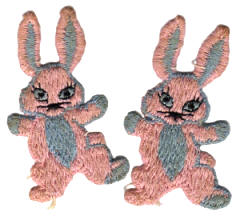 However, the bunnies proved to have a certain talismanic
power. It
wasn't unusual for a guy who had been checking me out in the dark bar, to move
in closer and only then get a clear shot of what the "patch" was. Often this
was used as a conversational gambit: "What are those?" There wasn't
anything to say, other than the obvious, "Bunnies." I mean you
couldn't call the fucking things "rabbits" with a straight face. "Bunnies"
signaled the moment of
truth. Kind of like The Lady or the Tiger. Me or the bunnies. If the
bunnies were an "issue" it was all over.
However, the bunnies proved to have a certain talismanic
power. It
wasn't unusual for a guy who had been checking me out in the dark bar, to move
in closer and only then get a clear shot of what the "patch" was. Often this
was used as a conversational gambit: "What are those?" There wasn't
anything to say, other than the obvious, "Bunnies." I mean you
couldn't call the fucking things "rabbits" with a straight face. "Bunnies"
signaled the moment of
truth. Kind of like The Lady or the Tiger. Me or the bunnies. If the
bunnies were an "issue" it was all over.
The Bunnies
Once a guy asked the question. And I said, "Bunnies." He looked down at them again, then at me. "Oh, for chrissake," and he walked away.
I mean, what was I supposed to say they're obviously not sabre-toothed tigers!
It took a hungry man to get past the bunnies.
About 1971, after my rather brief foray into the world of trendy finery, the hip hugging pants got pushed to the back of the closet, and along with them went the voile shirts and the loud colored satin ones as well. The pants got sent to a charity when I moved, and though I took the shirts with me, I don't think I ever wore them again and they went the same route a few years later. I continued to wear my denim bell bottoms, but as they wore out their replacements were "old fashion" Levis 501.
In March 1971 I became one of the last staff members laid off by Fairfield Reading as they went through a decline in business due to bad economic conditions and factors in the educational field. It had been a great place to work, and I missed it and the people there. Ken had started his own PR firm with a (straight, female) associate, and I went to work for them.
THERE GOES THE NEIGHBORHOOD
By the turn of the decade the area of the Upper West Side bounded by Central Park West and Broadway on the east and west and Lincoln Center and West 72nd Street on the south and north had been gentrified. West 72nd Street, a major cross-town street with two-way traffic, and a largely commercial thoroughfare from West End Avenue to Columbus Ave., proved a temporary dike to the process as did the other cross-town streets in turn West 79th, West 86th and West 96th over the next decades.
Business at the Candlelight Lounge had been booming. But suddenly it was no longer "the only game in town" in the neighborhood. The sharks were circling. Just half a block up Amsterdam, next to the Greeks, a bar called the Picadilly Pub opened in a former laundromat it worked hard to be "hot", something the Candlelight was not. The Lighthouse, a large, rundown cocktail lounge turned seedy boozer bar, located at Broadway and about 77th, became a gay bar called the Westsider. About this same time, across Broadway and just a couple of doors up a side street, a former bicycle rental store was turned into a bar, whose walls were decorated with high gloss modernistic stripes and bicycle frames.
The Ham and Eggs had vanished, and then "the Greeks" as well. The benches around the triangle of the Verdi monument, however, still accommodated a late night/early morning population of faces from your Post Office wall a few looking for sex, some rough trade, people prowling for a dope connection and the occasional prostitute.
Then the Candlelight Lounge went into high gear with a burst of nickel-and-dime decorating madness (a wall of shiny foil wallpaper with plaid stripes) and a pumped up juke box (nyah-nyah, told you so.) But it was like seeing your grandmother resort to breast implants. And the other bars, mainly the Picadilly, or the "Pic," sucked up many of its customers.
I had two social circles, which in their makeup were a reflection of the neighborhood's gay male population. The first was guys that I hung out with in the bars and outside of them as well, among whom were the people I considered my closest friends. There were seven of them four whites, three Hispanics and one Afro-American. The other group was four guys that I usually hung out with only in the bars, and all of whom I had sex with for several years. Two were white Americans, two were Hispanic.
Once the other bars opened I saw quite a few guys (mostly white and Hispanic, fewer American blacks) that I didn't recognize from the Candlelight, but as I got to know some it seemed that most of them had already been living in the neighborhood for a couple of years or more. Evidently they had not gone out often or had gone down to the Village. But the balance was still toward working class guys, most with "jobs" not careers.
The gay male populations of the Upper East Side and Murray Hill, etc. at this same time were much different overwhelmingly white, earning a good deal more money and with white collar careers. Like a friend, Bill, who lived over there, some were inclined to head to the Hamptons for the summer, finding the Pines now too tell-tale for their tastes. And Cherry Grove? Never!!
Quietly upscale-looking but affordable restaurants, e.g. Red Baron, the Library, Teachers had opened around the West Seventies, and by '71 Victor's a large Cuban restaurant near 72nd and Columbus was one of the latest trendy, must-go-to spots in town. What had happened below 72nd Street in the way of gentrification was about to make a big dent in neighborhood gay life farther north.
In '70 a friend from the Village, Jim, the guy who'd first invited me to Fire Island years before, dragooned me into seeing an Off Broadway play called Score. It sounded dreadful - and it was - but the male lead was the lover of one of his best friends. The story line (as I recall it now) was that a married bisexual couple make a bet with each other that he/she can be the first to score with the spouse of the same sex while entertaining a new couple in the neighborhood. The production promised lots bare tits and ass, very trendy since Che! and Oh Calcutta. What it delivered was very little except a zillion predictable double-entendres and a "climactic" scene - done in the dark with flashing strobes in which the husband and wife scored simultaneously, each getting oral sex. The only bright moment, and it was hardly more than that, followed when a pizza delivery guy showed up. He was a somewhat odd-looking fellow, but with a very hunky bod the show's only redeeming feature and he was pounced upon by both couples. Years later I found out that the "Pizza Delivery" guy was Sylvester Stallone.
ART APPRECIATION 101
In the spring of '71 I had picked up two guys in the Exile, an after-hours bar and dance club near the waterfront in the West Village, and we went back to my apartment. One of them was a fellow from Canada, Mario Amaya. About a month later I ran into him at the Zodiac, and he invited me and two or three other guys back to where he was a guest in a private house just off of Madison Avenue.
(right) Mario Amaya
His bedroom was on the ground floor at the rear of the house, and had probably been intended as a sitting room. It was paved in marble and had two pairs of French doors which opened onto a small, lushly green garden There was no furniture in the room, except for a double size brass bed, and after undressing we all piled into it. During the night it began to rain heavily. The garden doors were open, so the long voile curtains blew up into the room, looking like spirit wraiths, rain gusted in onto the marble floors, and in the grey morning light it was all theatrically soft-focus and shimmering though the scene on the bed was neither.
When Valerie Solanis had gunned down Andy Warhol and almost killed him in 1968, she also shot the person with him, and that was Mario Amaya.
The following year I learned that he had become director of what I used to call the Huntington Hartford Museum, though its real name was something like the New York Cultural Center. He mounted 150 different shows and attracted large crowds. Three that I enjoyed very much were a massive centenary retrospective of the paintings and drawings of Jack Yeats (still have the great catalog from the show, containing better reproductions of his paintings than are found in the standard references to his life and work.); one of the paintings of New York realist John Koch quiet upper crust household scenes which were several times used with great effect on the cover of the New York Times Book Review, and the last a dazzling show of Italian Art Deco, which included clothing, furniture, accessories and art work some by Ertι. Amaya's exhibitions were brilliantly eclectic, and skillfully filled chinks in the activities of the Metropolitan, Guggenheim and MOMA museums.
But he also ran up big, unrecoverable costs, and very unfortunately in my estimation the museum was closed in 1975 and put up for sale. (Mario died in 1986.)
During these years I discovered the poetry of gay poet Thom Gunn. I was also reading With Shuddering Fall and Garden of Earthly Delights by former Syracuse U. Journalism School classmate, Joyce Carol Oates; as well as the five-volume Children of Violence by Doris Lessing, set in colonial Rhodesia the last volume of which, The Four-Gated City still seems to border on prophecy...Eugene Herrigel's very popular Zen and the Art of Archery was on the menu too.
SEPARATE WAYS
At the end of 1971 I'd decided to move out of the apartment, as both working and living with the same person was not a good arrangement. My new home was a studio apartment in a once luxury building, now dumpy and badly patched up, at 201 West 80th and the corner of Columbus Avenue. It was directly across from the back of the Museum of Natural history (or "Margaret Mead's house," as some gay guys called it.) Only eight blocks away from West 72nd, it was, however, moving back to another world a mostly Hispanic and black enclave with thriving cottage industries in the form of prostitutes and their pimps plus two major heroin dealers, and patrolled by a neighborhood gang of kids who kept an eye on things for these "business" interests on the block.
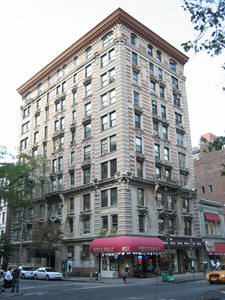 Don P., the white gay
friend who lived in the building and had helped me get the apartment, warned me,
"Don't walk down the block at night, use 79th Street."
Don P., the white gay
friend who lived in the building and had helped me get the apartment, warned me,
"Don't walk down the block at night, use 79th Street."
(right) Present-day 201 West 80th St.
Later I went to visit Bob the super, a congenial black guy, to pay him off with a quart of whiskey. We chatted for awhile, and as I was leaving he said, "Oh yeah...don't walk down this block at night." He put a finger to his dark brown cheek, "Even I don't do that." Got it. (Bob would later learn how much closer the danger in the neighbor-hood was.) These warnings might have been more scary if I hadn't already lived for several years in the early 60's one block north on West 81st St., between Columbus and Amsterdam avenues, which had been my Upper West Side baptism.
~ ~ ~ ~ ~ ~ ~ ~ ~ ~ ~ ~ ~ ~ ~
Doc Pomus (Jerome Felder), the writer of many blues and rock 'n' roll hits lived in the Westover Hotel on West 72nd in the 70's and 80's. The use of his legs had been seriously impaired by polio as a boy and for many years he walked with the help of crutches. By this time, however, he had to rely on a wheelchair, and sometimes you saw him parked on the sidewalk in front of the Westover. After his death in 1991 he was inducted into three of the music industry's halls of fame.
Doc Pomus is quoted as saying the songs he wrote in these years were about"...those people stumbling around in the night out there, uncertain or not always so certain of exactly where they were headed."
And these people were right on his doorstep and even closer.
Just a few months before I moved up to West 80's, I'd gotten my own literal eye-opener of a reminder when and where I wouldn't have expected it.
I had to get up at 6 a.m. to get ready for work, then hurry from the apartment to catch the subway downtown to transfer at Times Square for the shuttle train to Grand Central, where I caught a commuter train for my job in a Connecticut town. Even after a shower and shaving I operated in a half trance until I got to the train and could drop off into a nap for the hour ride out of the city.
One day as I was rushing up 72nd to the subway head down, half asleep a man's voice near me shouted at the top of his lungs, "Stop! stop! Watch where you're walking!"
I snapped to attention and saw I was passing the entrance to the Westover Hotel. But I was standing almost on top of a chalk drawing shit, and it was in the shape of a man, just like the movies! and there were gobs of red-brown on the sidewalk. I froze and looked around. I saw then that there were several cops dragging big wooden barricades from a truck to close off the sidewalk. I had blundered right into the middle of a fresh crime scene.
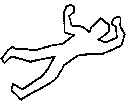 West 72nd was
not considered a
dangerous street, being a wide, well-lit busy cross-town thoroughfare. The
Westover, between West End and Broadway, was on
the north side of block and had
a metal marquee hanging over the sidewalk at its front entrance. It
was an apartment house or apartment-hotel, and recently on its top floor, which
had been an unused banquet room or ballroom, an after-hours club had opened.
At first it was rumored be to a gay place, then the word was that it had started to
attract straights too
reputedly the upper crust of the low life. I found
out what had happened the next time I picked up some shirts from the dry
cleaner-laundry about half a block further up the street. A pimp had been
in the club with one of his "girls." He'd had an argument with another
guy, also a pimp, from whom he had taken the girl away. About dawn the
couple left the club, and as they came out of the building the guy was shot
down. The girl fled up the street, and when she saw the dry cleaner was
open, ran in begging him to hide her. He did and called the cops.
West 72nd was
not considered a
dangerous street, being a wide, well-lit busy cross-town thoroughfare. The
Westover, between West End and Broadway, was on
the north side of block and had
a metal marquee hanging over the sidewalk at its front entrance. It
was an apartment house or apartment-hotel, and recently on its top floor, which
had been an unused banquet room or ballroom, an after-hours club had opened.
At first it was rumored be to a gay place, then the word was that it had started to
attract straights too
reputedly the upper crust of the low life. I found
out what had happened the next time I picked up some shirts from the dry
cleaner-laundry about half a block further up the street. A pimp had been
in the club with one of his "girls." He'd had an argument with another
guy, also a pimp, from whom he had taken the girl away. About dawn the
couple left the club, and as they came out of the building the guy was shot
down. The girl fled up the street, and when she saw the dry cleaner was
open, ran in begging him to hide her. He did and called the cops.
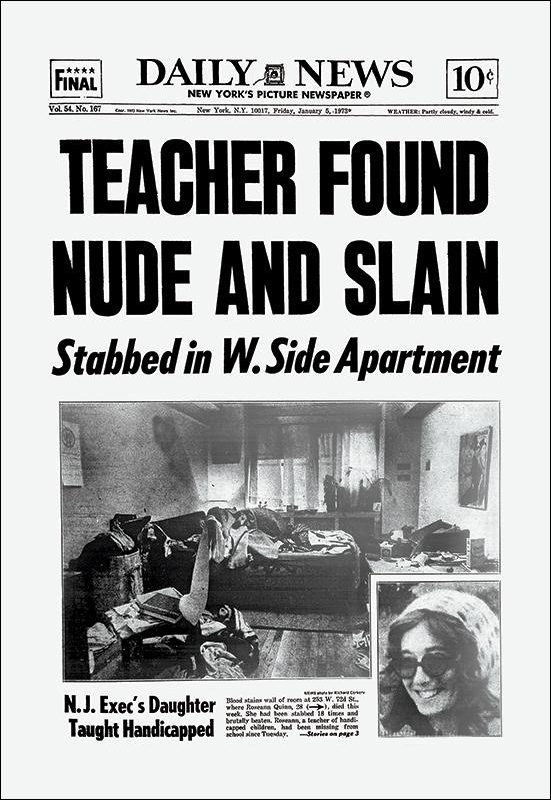 This building, though a respectable
enough place, had shit luck. In 1973, after it had become an apartment
building,
it was the site of the murder which became the basis for the
novel, Looking for Mr. Goodbar. In the dawning era of promiscuity
among young American females it was a best-seller morality tale. The victim, a young school
teacher, picked up a handsome, charming young guy in a place called H. M. Tweeds at 250 West 72nd, just
across the street. (A nice little pub type bar, the All State Cafe, later operated in the same space.) She took him back to her place
and
after an unsuccessful attempt at sex he killed her.
This building, though a respectable
enough place, had shit luck. In 1973, after it had become an apartment
building,
it was the site of the murder which became the basis for the
novel, Looking for Mr. Goodbar. In the dawning era of promiscuity
among young American females it was a best-seller morality tale. The victim, a young school
teacher, picked up a handsome, charming young guy in a place called H. M. Tweeds at 250 West 72nd, just
across the street. (A nice little pub type bar, the All State Cafe, later operated in the same space.) She took him back to her place
and
after an unsuccessful attempt at sex he killed her.
So, it wasn't just the grand old West Side buildings that ended up like shipwrecks.
By then I had made my move on up to 201 West 80th into another grand old shipwreck of a building...which was waiting on the corner of Columbus Ave. for its own blood offerings.
mail to:nycnotkansasat-signgmail.com
![]()
CONTENT-RELATED LINKS -
checked 30 January 2020
(Each section has its own list of
links)
Monogamy - Salon article
Working Class Gay Men - interview with author of Everything I Have Is Blue
Everything I Have is Blue - ongoing project concerning working class gay men
Brooklyn Boys - a beautiful, large format presentation of Danny Fitzgerald/Les Demi Dieux photos. A belated, but magnificent tribute.
The Dorilton - the building that says, "I am magnificent - fuck you!"
Club 82 - famous for female impersonaters
Judy Garland - concise, fact-filled Wikipedia page, this is not a shrine page.
Alison Steele - page on the Nightbird, many links (a bit slow to load)
Black Music During the Sixties & Seventies - from a black perspective
John V. Lindsay - a condemning evaluation of Lindsay
60's riots - a discussion of the causes and types of rioting
Columbia University (NYC) riots
Vietnam War - fantastic site, superb pictures and very moving
Stonewall: Get a Grip article on the over-emphasis of Stonewall's place in Gay Liberation
Ed Murphy (of Stonewall fame) - read section "The Improbable Life of Ed Murphy"
The East Village Other newspaper
GENERAL INTEREST LINKS - checked 30 January 2020
William Gedney photographs gay photographer, see photos of NYC and San Francisco in galleries section